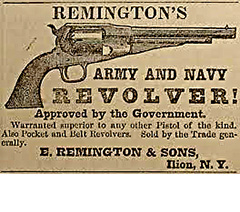
Please send all Checks and Money orders to :
Dave Taylor P.O. Box 87 Sylvania, OH 43560
419-842-1863
Click Here to E-mail Us!
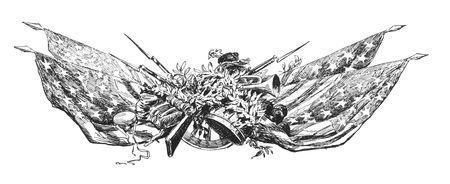
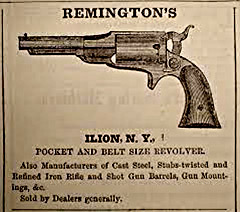
13 11
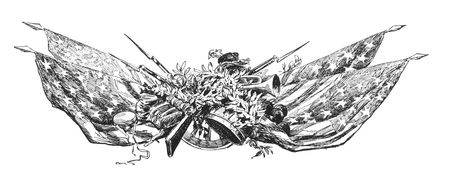
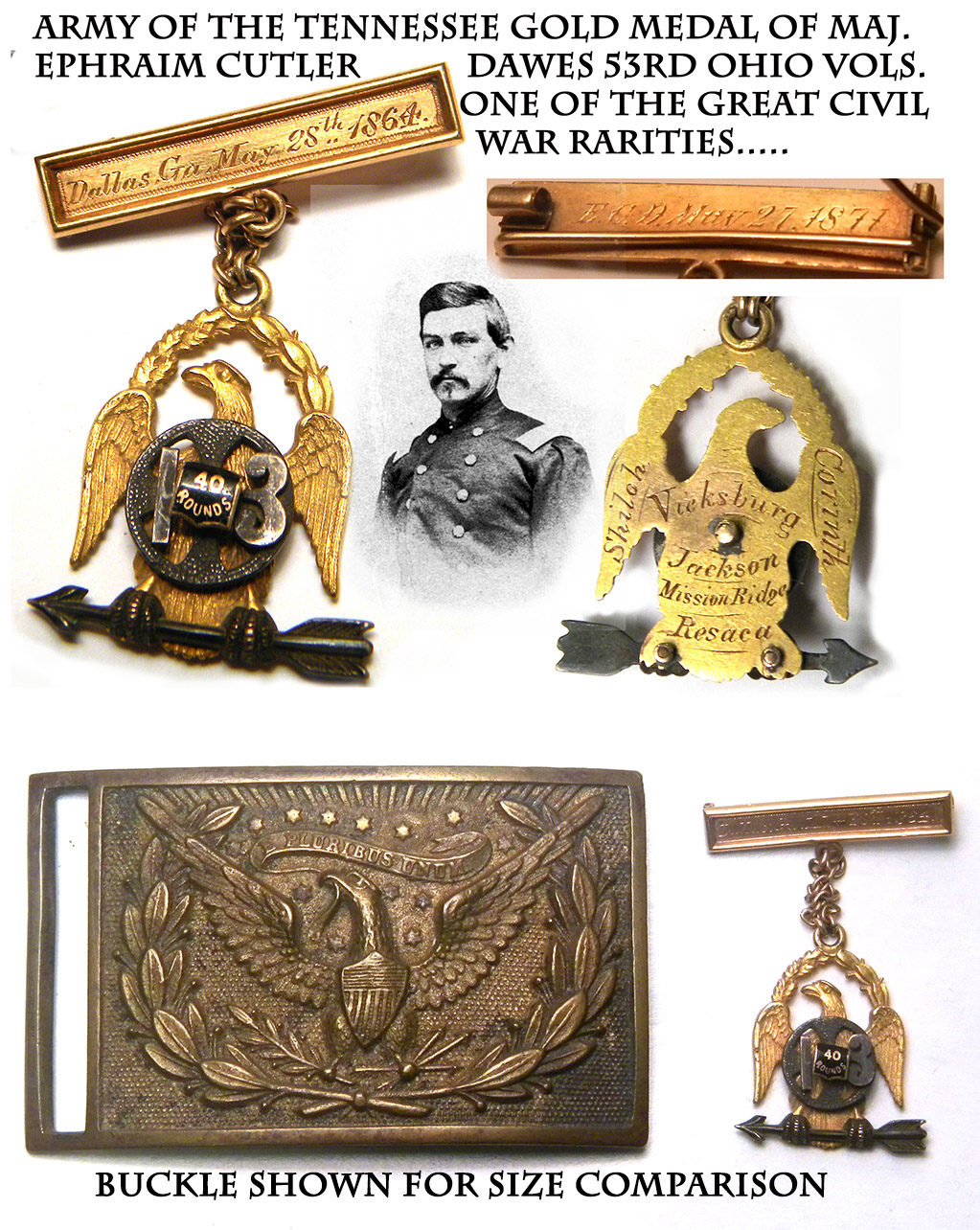
13-11-01 … A WOUNDED HEROS GOLD MEDAL.
EXCEEDINGLY RARE GOLD & SILVER SOCIETY OF THE ARMY OF THE TENNESSEE MEDAL INSCRIBED AND
OWNED BY MAJOR EPHRAIM C. DAWES, 53rd OHIO,
WOUNDED IN ACTION AT DALLAS, GA. AND THE BROTHER OF RUFUS DAWES OF THE 6th WISCONSIN IRON BRIGADE:
A MAN WHO COULD ENDURE WHAT MAJOR DAWES HAD THAT DAY WOULD BEAR BURNING AT THE STAKE!
The Army of the Tennessee medal is one of the scarcest and most impressive of the Civil War army medals.
Suspended from an upper bar, the 40 Rounds cartridge-box corps badge of the 15th Army Corps is superimposed on the 16th Corps badge of a disk with four minie balls cut out of it, resembling a Maltese Cross, and is flanked by the number 13 for the 13th Army Corps. These insignia are all on the chest of an eagle which has a wreath above, with a suspension ring, and holds the arrow badge of the 17th Army Corps in its talons. The eagle and wreath are gold the corps devices are silver The Society of the Army of the Tennessee is a wartime organization and was formed by officers in the army before the fighting had ended. On April 14, 1865, during the Campaign of the Carolinas, after Sherman had occupied Raleigh, they met in the state senate chamber and organized the society, To keep alive that kindly and cordial feeling which has been one of the characteristics of this army during its career in the service.” Our medal is a beautiful example in gold and silver and a wonderful inscription for the gallant officer who wore it. . On the top suspension bar is engraved, Dallas, Ga. May 28th 1864, and on reverse of the suspension bar: E.C.D. May 27, 1871. These are the initials of Ephraim Cutler Dawes, the brother of the famous Rufus Dawes of the Iron Brigade, and the dates are the dates of the presentation of the badge in 1871 and the date of his wounding almost exactly seven years earlier. (It should be noted that CWData has a mistaken entry for the date of his wounding: they list it as May 17, but he is clear in his own letter, see below, that it was May 28.) On reverse of the eagle portion of the badge are Dawess personal battle honors: Shiloh and Corinth on the wings; on the body of the eagle, Vicksburg/ Jackson/ Mission Ridge/ Resaca.
Dawes was living in Cincinnati when he enlisted at age 21 as a 1st Lieutenant on 9/26/61 and was commissioned First Lieutenant and Adjutant the same day. He made Major 11/1/62, and served until wounded at Dallas, GA, 5/28/64. He was then sent to the officers hospital at Lookout Mountain and eventually to Grant Hospital in Cincinnati, from where he was discharged 10/25/64. He died in Cincinnati in 1895 and was buried in Constitution, OH, where he had been born in 1840. The 53rd Ohio organized in late 1861 and mustered into service in February, 1862. It was engaged at Shiloh in Shermans Division and then in the siege of Corinth. In mid-1863 it participated in the Vicksburg campaign, fighting at Black River. It saw action at Missionary Ridge later that year and in the Atlanta Campaign in 1864 fighting at Resaca, Dallas, Kennesaw Mountain, etc. At Dallas they were engaged with the enemy from May 26 to May 31. On May 28 they were the principal target of a charge by Finleys Florida Brigade, which charged them in a column of regiments, but was beaten off with loss. It was in this fighting that Major Dawes was severely wounded. Here is Ephraims account of his wounding in a letter written shortly after: “I was shot at Dallas, Georgia, two weeks ago to-day. We were in rifle .pits. The rebels charged us. We gave them an awful licking. The bullet struck the left side of my lower jaw and, the surgeons say, ‘carried away the body of the inferior maxilla to near the angle. It took off my lower lip, tore the chin so that it hangs down, took out all the lower teeth but two, and cut my tongue. It is a horrible looking wound and will disfigure me, but the doctors say they can fix up a face for me. It will be slow healing. A few minutes before I received this wound I was hit in the back of the head. It did not hurt much and is not at all serious, although it is not yet healed. Our regiment has done splendid fighting this campaign, and has made a reputation second to no regiment in the 15th army corps.
Rufus Dawes followed this up in 1864: A wounded soldier’s journey home. Written by my brother in 1864. I was shot late in the afternoon of May twenty-eighth, and remained in the field hospitals, at and near Dallas, Georgia, until the night of May thirtieth. About ten o’clock at night of the thirtieth a wagon train was sent under strong escort to the railroad at Kingston, about thirty miles distant. All of the wounded who were able to travel in the wagons were permitted to go. The surgeons advised me to go in this train. They said that if I remained around the hospital the chances were that I would contract gangrene or erysipelas and die, and that I should get home as quickly as possible. My old friend Haydn K. Smith, correspondent of the Chicago Journal, volunteered to go to Nashville with me. I could hardly have got along without him. He had been with the army enough to know what to do and to whom to apply in an emergency. My colored servant, Wesley Benson, accompanied me. He was a faithful and competent young man but he could not read writing and I could not talk. The wagon train unwound itself at midnight. I got into one of the wagons and sat on a bag of corn. The different surgeons bid me good bye. I sat on that bag of corn all night. The road was very rough, much of the way through dark woods. My wound was much inflamed and my tongue so swollen that it was almost impossible to swallow. The misery of that night’s ride was indescribable. Early next morning Major Patrick Flynn, of the ninetieth Illinois, who was commanding the train guard, saw me and brought up the only ambulance in the train. It was loaded with mail bags, but Major Flynn threw some of them in the wagon and put me in the ambulance and helped fix the mail bags so that I could rest on them. Mr. Smith got a canteen of cold water, I managed to swallow a little of it, but the effort was so painful that I almost concluded not to try again. The day was very hot and the road was very dusty. About noon we crossed the Etowah river on a bridge. Near the end of the bridge was a house where there were some Union soldiers and some women. One of the women brought out a great yellow bowl filled with buttermilk and handed it to me. I was weak with hunger, faint from loss of blood and burning with thirst. I crammed the bowl into my mouth with both hands, despite the awful pain, and drank nearly the whole of the buttermilk. It revived me at once. It satisfied both hunger and thirst, and settled the question of supplies. I could walk and I could eat, and felt that my worst troubles were over. The train reached Kingston between five and six o’clock in the evening. There seemed to be no adequate preparation for the wounded. But the agents of the Sanitary Commission were there. They took possession of a large house with a shaded yard and went to work to prepare food. Mrs. Bickerdyke and Mrs. Johnson were in charge. I camped in a corner of the porch, surrounding the house, where there was a projecting room. I could not lie down, for breathing was then impossible. I could not rest the back of my head against anything, for the “wound there was very painful, and I was obliged to sit up in some place where I could rest the side of my head. This corner filled every requirement. One of the women brought me a bowl of soup. I took off my bandage to drink it. She looked at me, burst into tears, and ran away. An old gray haired surgeon came in to dress the wound. At sight of it he turned very white and went away. Mr. Smith had gone to ascertain about the railroad trains, and Wesley was hunting a newspaper, so I went out myself to find a surgeon. Fortunately my good friend, Dr. Edwards of the fortieth Illinois, who had been attached to our regiment in the East Tennessee campaign and messed with me, met me in the yard. He spent an hour dressing my wound and gave Wesley full and careful instruction how to care for it ; that night I slept well. Next day, June ist, about noon, a train of empty freight cars backed down in front of the house. Mr. Smith came in with the news, that all the wounded who were able to walk, were to go to Chattanooga on that train. I got into a car with a large number of others ; so many that all had to sit up. Many of them were badly wounded, but all were in high spirits. At Resaca, as the train stopped, I was startled at the sight of Wm. D. Gaby, a soldier of company “K,” of our regiment. At the battle, on May 13th, he was shot dead as we all supposed. The ball struck him in the forehead, but glanced and came out the top of his head. The train reached Dalton at dusk. I was very tired, and getting out of the car walked along the platform to a car where there was more room. It was occupied by a dying officer, with a surgeon and a detail of men sent to care for him, and endeavor to get him far enough North to meet his father and mother who were hurrying down in answer to a telegraphic summons. The officer was Lieutenant George B. Covington, Adjutant of the seventeenth Indiana regiment. He died before the train left Dalton. The surgeon seeing that I was badly wounded and very weak, gave me some stimulant and put me on Covington’s cot, raising the head so I could rest. I went to sleep, but at Ringgold, woke with a start to find my bandages drenched with blood from some small arteries under the tongue, which had sloughed away. I stopped it by cramming a towel under my tongue. This weakened me very much and made me afraid to sleep again. About midnight the train reached Chattanooga. There was no one at the depot to tell us where to go. I saw the row of hospitals on the hill near by and started toward them. A guard cried : “Halt !” “Halt ! ” but I did not care whether he shot me or not, and pushing past him, opened the door of the nearest building, which was the officers’ ward. The nurse on duty was a wounded soldier. He knew exactly what to do, dressed my wound carefully, fixed a cot so that I could rest comfortably, and I slept until the surgeon came around in the morning. Mr. Smith after some trouble, secured a pass for me to Nashville. The nurse fixed up a large roll of bandages and a bottle of beef tea and gave them to Wesley for me. The train left at three P. M., June 2nd. It consisted of a number of empty freight cars with a single second class passenger car attached. The car was pretty well filled. I sat on the rear seat, (the seats were plain boards) with my back to the other passengers, as I was obliged to change my bandages frequently. The train went via Stevenson, Huntsville and Decatur, and did not reach Nashville until late in the afternoon of June 3rd. This railroad ride was the most trying experience of all. My wound was sloughing freely, my tongue was very much swollen and it was almost black. I suffered a great deal of pain, and to swallow was exquisite torture. At Nashville I was taken to the officers’ hospital. Under the efficient care of Dr. J. H. Green, the surgeon in charge, I improved rapidly,’ and having obtained a leave of absence, was able to leave for home June 6th.” Ephraim Dawes, however, omitted some of the most trying details of his ordeal, and it was left to his brother to record them: One more duty yet remained before I was done with my service in the war. It was to be with my brother while he passed through the ordeal of the surgical operation. This was performed in a building at Fairmount, near Cincinnati.Ohio, which was then used as an officers’ hospital. Dr. George C. Blackman, one of the most skillful surgeons in the country at that time, performed the operation. My aunt, Miss Julia P. Cutler, wrote to our sister in Persia, giving my own contemporary description of the operation. Marietta, Ohio, September 24th, 1864. My Dear Jane : Just before bed time Rufus and Mary came in, he having come up from Cincinnati to-day. Dr. Blackman performed the operation at the officers’ hospital. Rufus remained with him through the whole, and helped hold his hands while it was done. He was an hour and a half under the surgeon’s knife and not under the influence of chloroform. During the four months which intervened since the wound was received, the jagged flesh had been put together and a sort of chin formed, so we hoped that the operation would not be an extensive one, but in this we were disappointed. The flesh was all cut loose, then a gash cut through the cheeks on both sides to the angle of the jaw; slits were then cut parallel with them, in the same direction, so as to get a loose strip of flesh an inch wide, which was only attached to the face at the angle of the jaw. These strips were pulled and stretched so as to meet over an artificial under jaw and teeth, to form an under lip. The tightening and stretching of these strips caused the upper lip to be pushed out of place and protrude, so a gore had to be cut out on each side and sewed up. Then the flesh which had been loosened from the chin was put back and trimmed so as to fit in with the new under lip. He lay upon the table unbound, Rufus holding his left hand. His self possession was remarkable, obeying every direction of the operator, turning his head as directed, until the agony and the loss of blood exhausted him, and only a shiver ran through his frame. After it was over and stimulants administered he rose and walked upstairs to his room. Dr. Blackman considers the operation a great success. He invited a number of physicians to be present. One of them told Rufus that a man who could endure what Major Dawes had that day would bear burning at the stake.
It is a pathetic memory to me that when my brother had been told that the operation was over, Dr. Blackman, looking at his work, said : Major, I must finish up with two more stitches. The Major, to whom there was left no voice, raised up one finger to plead for only one. I cried: Dr. Blackman, don’t touch him, and he then raised up both fingers and the two stitches were taken. During the operation he came near strangling with the blood in his mouth, and in a spasmodic effort to get his breath, threw out the false teeth and jaw, which were not replaced. It is perhaps well that they were not, but this made necessary a month later a second operation of comparatively limited extent. To the casual observer no trace appears under the full beard now worn by Colonel Dawes, but a glance will show the marks of the “gores” cut in his upper lip. Captain Wm. Wilson, now of Cleveland, Ohio, and Captain W. R. Thomas alternated with me in holding my brother’s hand.
This is a remarkable memento of the war and has everything going for it: the medal itself is a piece of art, the immeasurably brave officer who received it endured suffering beyond comprehension in the service of our country. The condition of the medal is extra fine. I dont say this often, but it is an honor to handle this piece. I wonder why the family parted with it ever.
… $3,650.00 SOLD
Click Here to E-mail Us!
Call us @ 419-842-1863
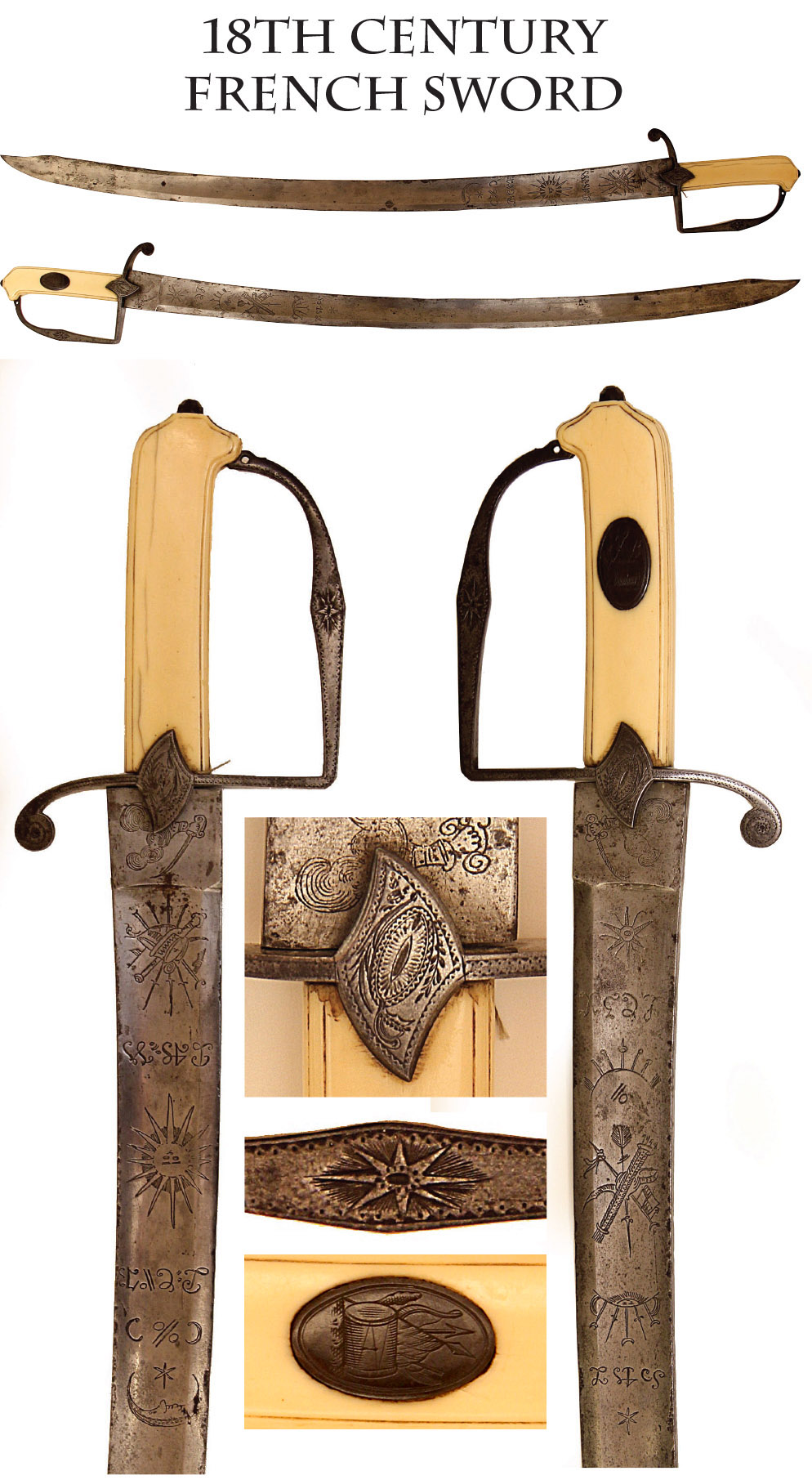
13-11-02 … 18th Century Ivory-gripped, Silver Inlaid, Iron Mounted Officers Short Saber,
Cutlass or Couteau with Clipped Point Blade Profusely Decorated with Panoplies of Arms and Cabalistic Signs. I generally dont buy early European weapons, but this one really grabbed me. I felt it could have been carried in any number of historical battles. It is a French made sword intended to evoke images of the early exotic ages with talisman marks and some mystical signs associated with the Kabbalah.
Ivory hilt with incised lines running along the edge on both sides of the rectangular-cross sectioned grips. High capstan rivet pommel with slight pistol-grip-flare. Outboard side of the grip has an inset oval silver plaque engraved with a very French trophy of arms consisting of a drum, flags, bow and spears. Single knucklebow guard with central eight-pointed star and rays motif on either side with an engraved toothed line on either edge with punch-decorated dots. Slightly downturned flat round quillon that continues the motif into a spiral. Recurved langets with mixed floral and geometric motifs and the same punch decorated jagged border. Small hole at top of knucklebow for a sword knot. Overall length is 33.75 inches. The 28.5 inch blade is single edged with a wide ricasso, single broad fuller and clip point with false edge. Both sides of the blade show an etched or engraved sword-wielding arm appearing out of a cloud at the ricasso. This motif is found on many early swords, 18th century and prior, and represents The Sword of God. It can be found on weapons from Europe to the Middle East. A precursor to Germanys Gott Mitt Uns, and every nations belief that God is on their side, especially during battle. On the inboard side above this is a trophy of arms, some mystical numbers and letters, a sun with a face and pointed rays, followed by two more rows of mystical signs and lastly a man-in-the-moon looking down on a star. Similar motifs are found on Revolutionary War blades. On the outboard side, a somewhat floral star sits under more mystical symbols. Above that a long oval panel with the face of the sun at top has the bases and tops of pole arms peaking up behind it, while on it is another trophy of arms showing an arrow, quiver, flag and clip-pointed sword like this one. Above that is another set of mystical signs topped by a star.
The blade is very clean, just some minor gray and dark spots here and there, slightly more near the tip, but very, very legible from across the room. The grip is extra fine and solid ivory and silver. Extremely minor chipping at the base near the guard, a couple of dark lines showing from deep inside. The story of the old-testament rooted mysticism of the Cabala or Kabbalah, its roots and many off-shoots in Judaism, Christianity, mysticism, freemasonry, etc., is too vast to deal with here. There were a number of upsurges in interest in its mysticism in Europe starting in the Renaissance. My feeling is that the sword dates about 1750-70 and the owner was either truly interested in the mysticism of the symbols used on the blade or he wanted a blade that evoked the mysterious east: This is very pretty and exotic sword, and one meant for business. Eye catching, fearful, handsome, this one stands out in an edged weapons collection.
… $2,950.00
Click Here to E-mail Us!
Call us @ 419-842-1863
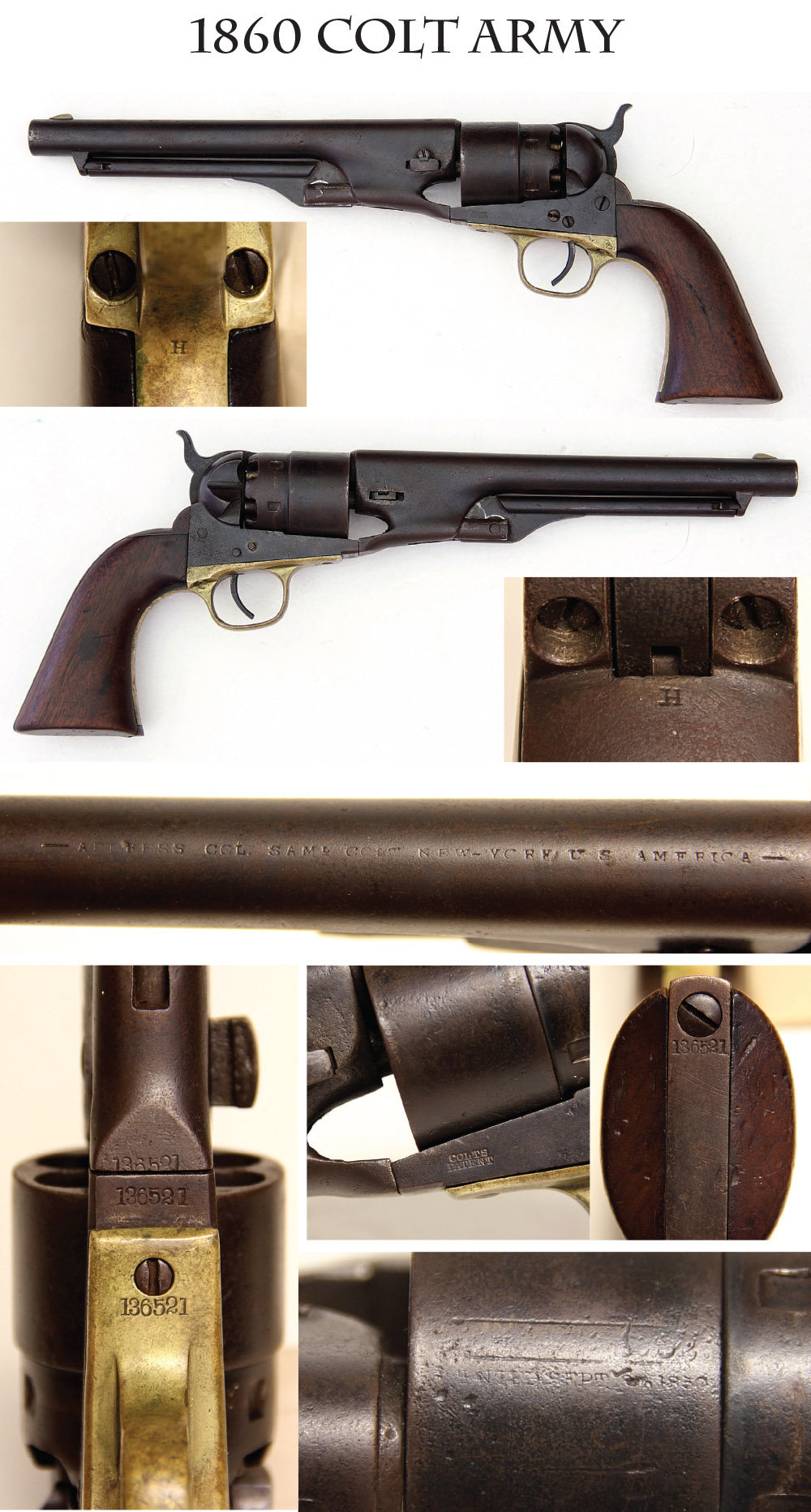
13-11-03 … Model 1860 Colt Army Revolver –
Very good example with Serial Number 136,521 all matched except the wedge which bears no number but is definitely an original Colt Wedge. The top of the barrel is nicely and properly marked ADDRESS COL. SAML COLT NEW-YORK U.S. AMERICA. The grips are super with both sides having a visible cartouche. Grips vg to fine. All metal surfaces are smoky brown mixed with plum patina. There are faint remnants of cylinder scene and some light pitting near the nipples. Cylinder number is quite worn but partially visible with a glass. Totally original, complete, and mechanically perfect. A very honest and appealing example of the classic Civil War cavalrymans sidearm. Nice atticky look with warm brown patina
… $1,495.00 SOLD
Click Here to E-mail Us!
Call us @ 419-842-1863
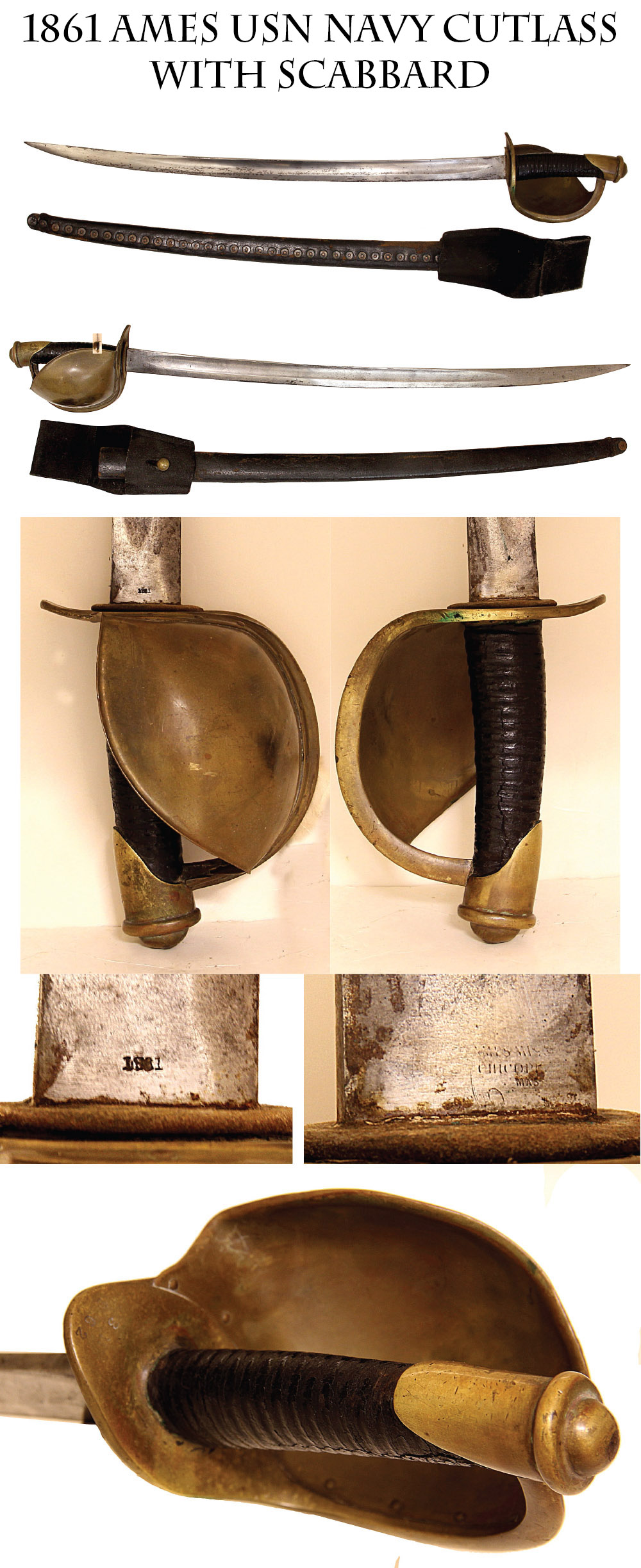
13-11-04 … A Very Good original example of an Ames 1861-dated US Model 1860 USN government naval cutlass
that was carried by U.S. Navy seamen aboard ship during the Civil War. The blade on this boarding cutlass is VG, measures 26 long, 1 wide at the ricasso and has a flat back with a single, wide, unstopped fuller with a dark gray patina. Blade exhibits scattered light pinprick pitting in select areas with a number of tiny nicks on the blade. Ricasso has a very thin makers three-line address that reads _Ames MFG Co / CHICOPEE / MASS. The obverse 1861. Stampings are light. Brass hilt is excellent as is the leather grip. Wire has been removed which is proper. Cutlass has the original leather washer. Scabbard is excellent. … Has its brass stud or finial strongly secured to the body at top edge of the scabbard. All forty copper rivets are tight along the seam. And, it is complete with original belt frog! A nice, solid Civil War naval cutlass with scabbard and belt frog.
… $1095.00 SOLD
Click Here to E-mail Us!
Call us @ 419-842-1863
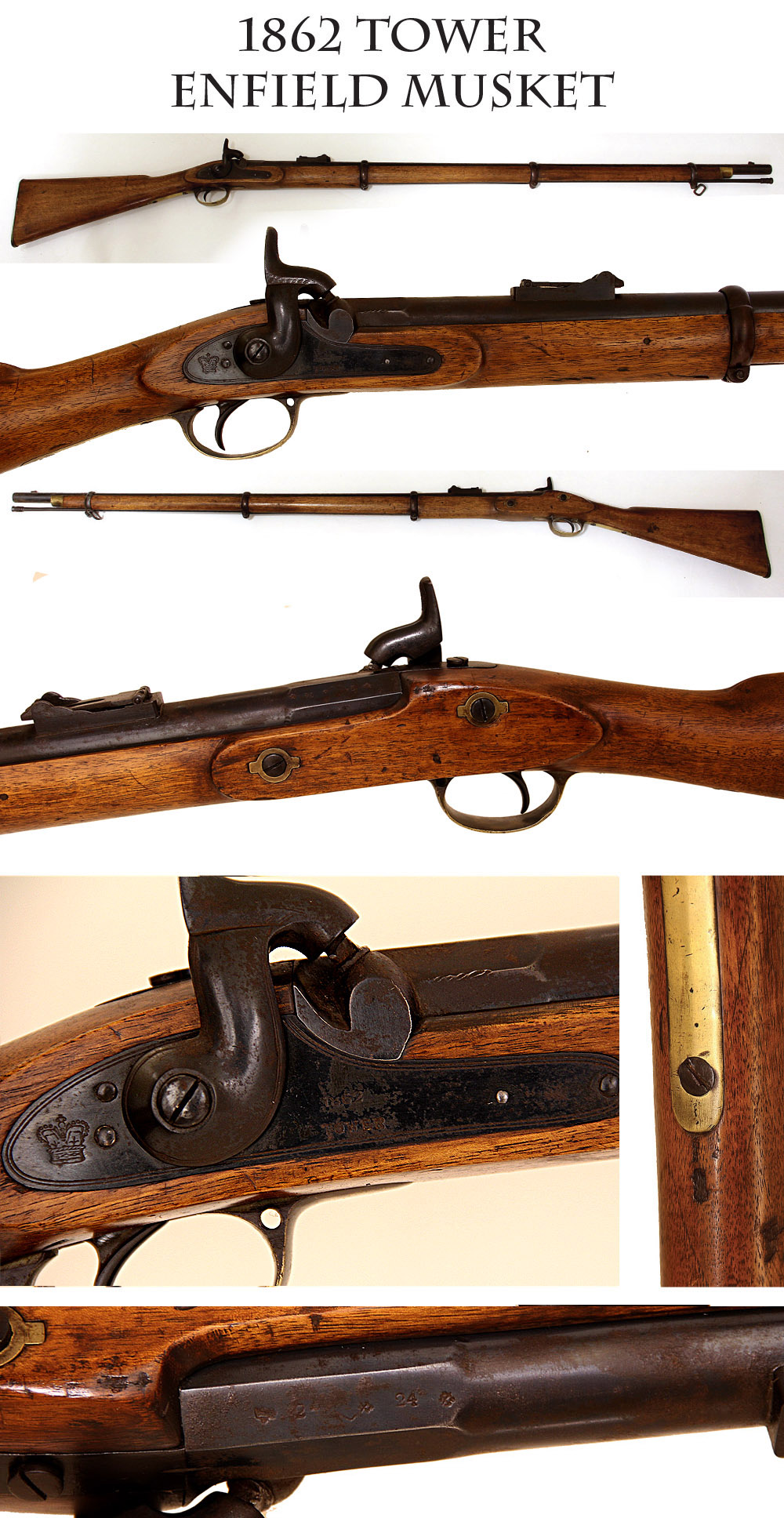
13-11-05 … Scarce Variant Civil War Tower Enfield Rifle Musket / Confederate 40 Inch Barrel in .58 Caliber:
The quintessential P53 Enfield as used by both Union and Confederate infantrymen. This one is NRA very good+++ condition. 100% original, 100% complete (except for the sliding elevation bar on the rear sight which is gone), mechanically perfect, super bore, and very handsome. Lock is clearly marked 1862 TOWER and bears the CROWN stamp. The barrel bears the scarce 24*24* stamping showing the gun is .58 caliber and as such there are 24 bullets to the pound. This is far rarer than the standard 25*25* mark which indicates standard .577 caliber. In the wood behind the trigger guard tang are two tiny stamps. See illus. The rarest element of this Pattern 1853 is the 40 inch barrel with elongated octagonal breech. These barrels are normally found with the standard Birmingham view, proof and gauge marks, (as this is) and are additionally marked with a C within a Diamond, thus giving them the collector name Diamond C barrels. This barrel has a partial diamond stamp visible. There is much speculation about the source of these barrels, and many believe that they are Colt barrels made at Pimlico contracted for in England and then either not delivered or rejected. One thing that is certain is that these barrels usually show up on early dated guns (1861 or 1862) and are often accompanied by CS importation marks and even CS state marks. A wonderful early Enfield with strong Confederate possibilities.
… $2,350.00 SOLD
Click Here to E-mail Us!
Call us @ 419-842-1863
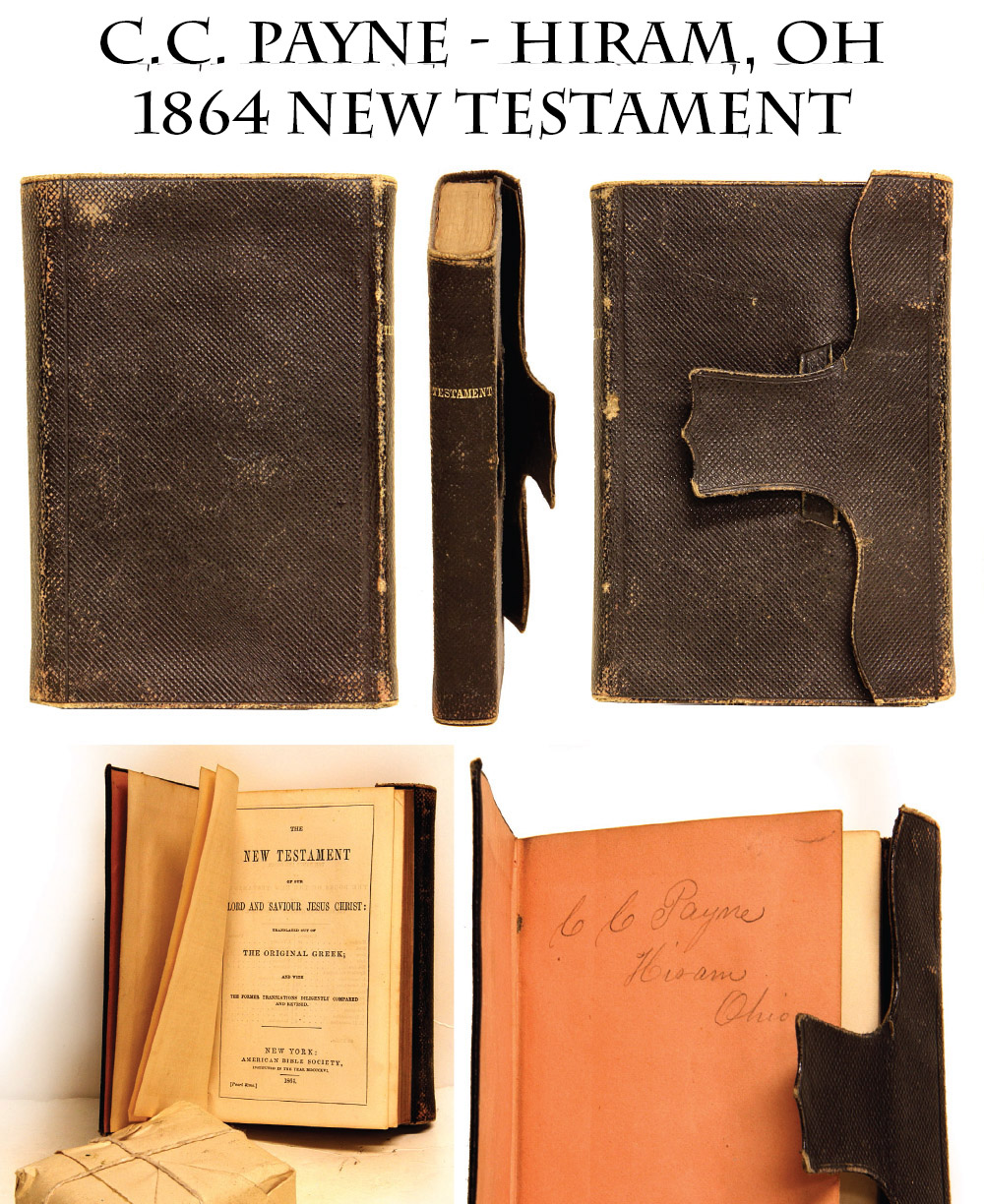
13-11-06 … 1864 Dated American Bible Society Pocket Bible.
Many thousands of these made their way into soldiers hands as gifts from loved ones or religious groups seeing soldiers off to war. They were carried in the camp and field and for a collector are a key part of a display of a typical soldiers personal effects. Pebble grained leather cover with a friction tab that slips through a standing loop to keep it closed in the pocket. Inscribed in pen on the flyleaf C.C Payne/ Hiram/ Ohio. Research shows numerous Ohio soldiers named C. Payne, but none listed as CC. Perhaps research will reveal the owner. This would add to a Civil War display as a typical example without breaking the bank.
… $89.00 SOLD
Click Here to E-mail Us!
Call us @ 419-842-1863

13-11-07 … Early civilian 36 caliber bullet mold
… and bullet!
… $39.00 SOLD
Click Here to E-mail Us!
Call us @ 419-842-1863
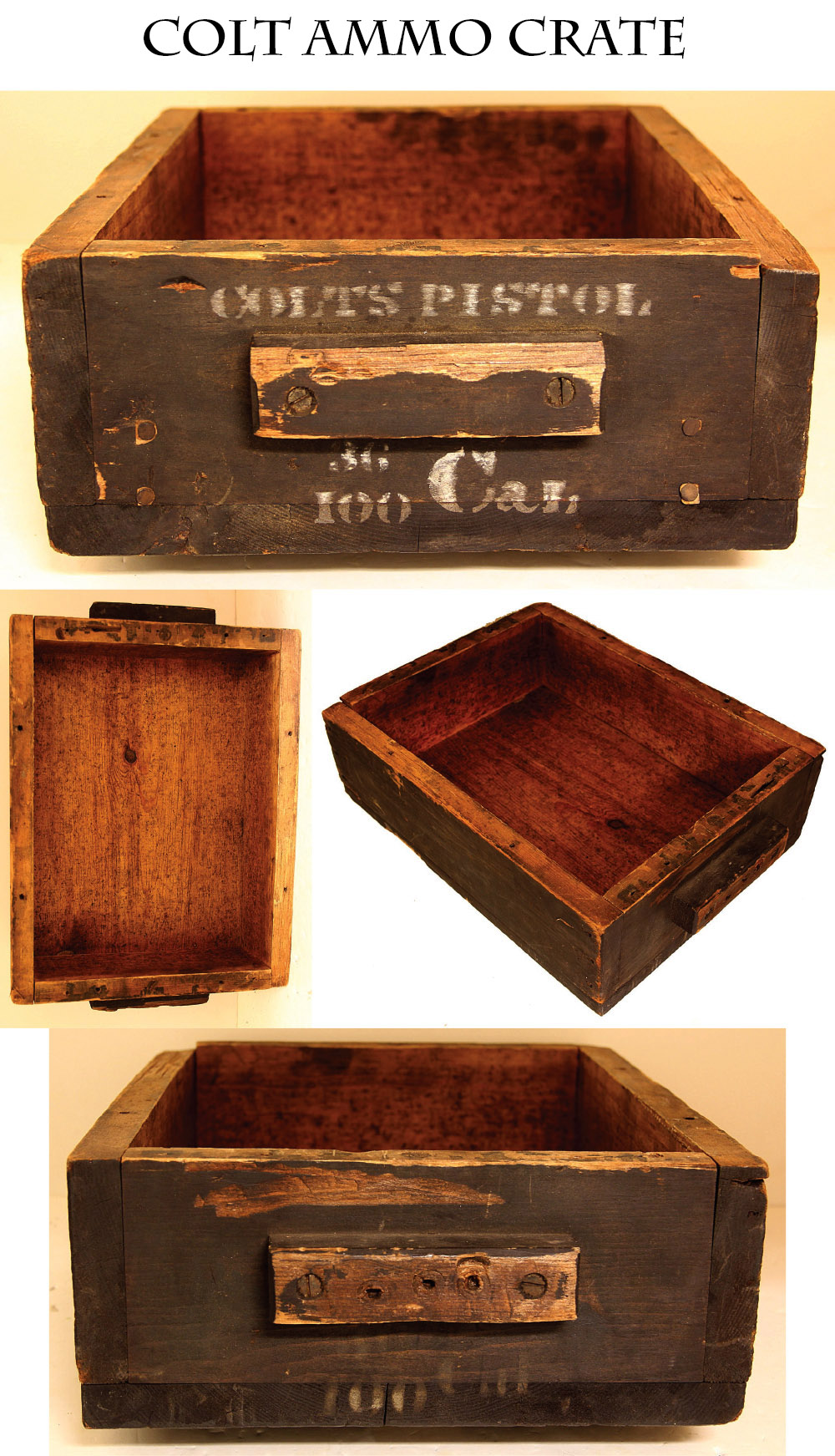
13-11-08 … RARE CIVIL WAR COLT .36 CALIBER AMMO CRATE FOR THE 51 NAVY.
These ammo crates were not meant to survive! Intended merely to get ammunition from the arsenal to troops in the field, ammo crates are about the rarest of military relics and yet there were a lot of them in many different forms. As rare as they are in general, this one is even more special in having contained ammo for the .36 Colt and is specifically marked for that weapon. I dont need to tell you how many cavalry regiments were armed with .36 Caliber Colt Navies. (A lot!) Painted a deep olive green, the box has a rectangular carrying handle at each end. Clearly stenciled in white on one end is visible Colts Pistol over the handle and 36/100 Cal. below it. The other end had the same marking, but only the caliber designation is faintly readable. The sides and bottom were nailed together, the lid, now missing, was screwed on, as are the handles (present). Four small tacks show where someone later tacked on a label when he reused the box for something else, for which we can be grateful because he preserved the crate and also the stenciling. There is some chipping to the wood, particularly to the handle on more prominently stenciled end. Overall this crate is not only rare but in exceptional condition and would look great in a cavalry display with a Colt across it and some of the pistol cartridge packs. They must have been a common sight around camp, but once emptied were mostly used for firewood or camp furniture. Every now and again they surface from a military goods dealer who used them to hold gun parts once. I was very happy to snag this one, and if you like Colts, the cavalry, or Civil War ordnance in general, you will be, too.
… $850.00 SOLD
Click Here to E-mail Us!
Call us @ 419-842-1863
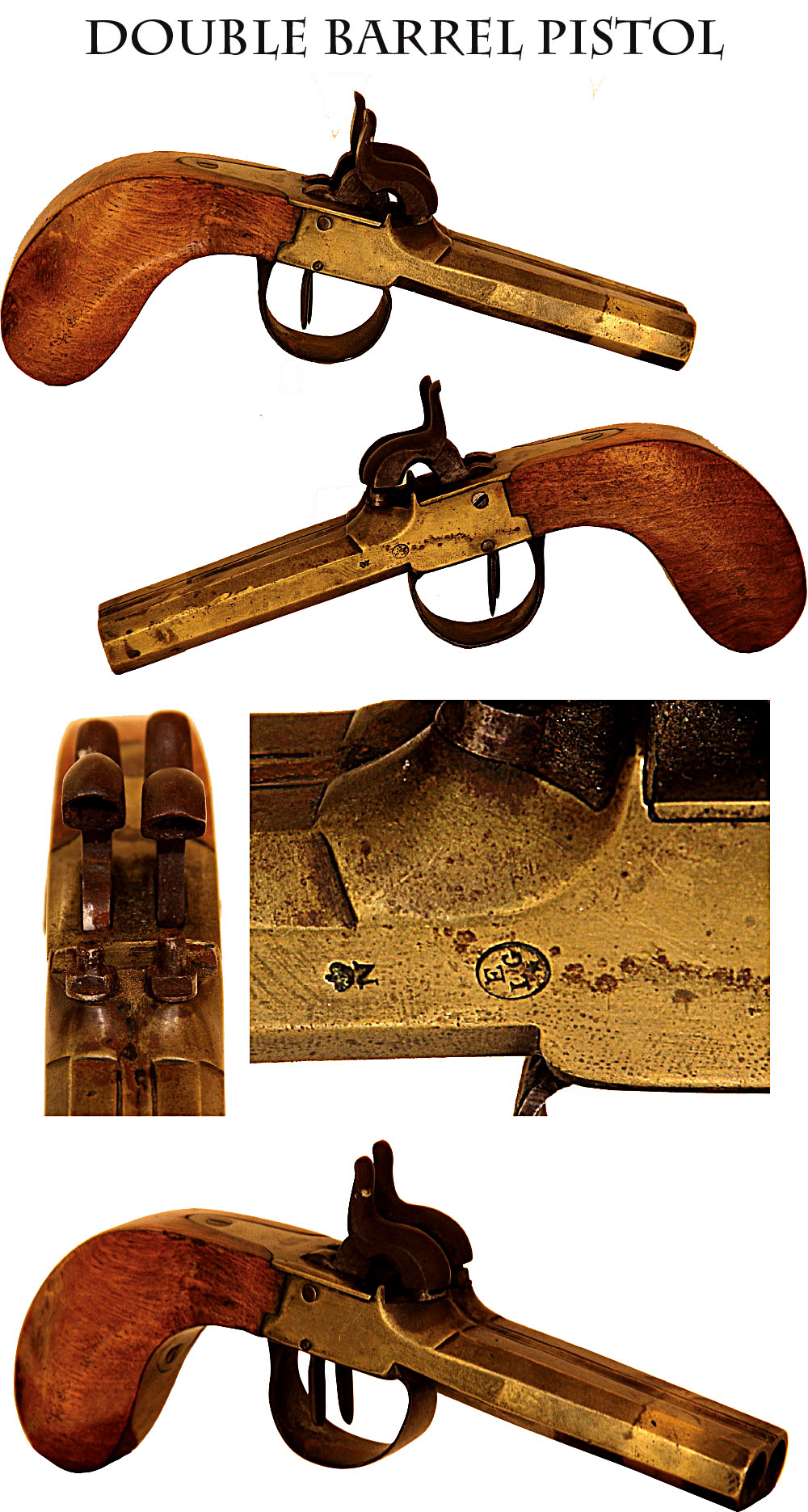
13-11-09 … Belgian Double Barrel Brass Belt Pistol.
NRA very good. Pics tell the story. Circa 1845-1860
… $275.00 SOLD
Click Here to E-mail Us!
Call us @ 419-842-1863

13-11-10 … CIVIL WAR REGULATION ISSUE ARMY HAVERSACK:
Napoleon said an army travels on its stomach and the US army in the Civil War was no exception. The haversack was the regulation issue piece of equipment to hold the soldiers food and mess gear, and along with his canteen and rifle accoutrements, the soldier kept it close by. On the march, he hung it over his right shoulder to hang on his left hip. This pattern was introduced about 1858 after trials of several different types to replace the Mexican unpainted cloth version, and consisted of black painted Russia sheeting with a non-adjustable wide strap of the same material, the body being closed by a single strap and buckle, with three tin buttons on the inside to retain a removable inner cloth liner or rice bag. There were a number of variations and commercial patterns, but what I offer here is the regulation issue US army pattern in very good condition with just a minor tear on the lower left side and a couple of small tears and loose stitching where the shoulder strap is sewn to the upper rear corners of the bag. The tin buttons are in place inside, but as is almost always the case, the inner bag is long gone, in many cases these seem to have been removed and used for other purposes. The leather fastening strap has been repaired where a length had broken off. The roller buckle is in place on the front. These have always been a scarce piece of Civil War gear- they were too useful an item around the farm or house after the war to survive long. Even when Bannerman and other surplus dealers still had stacks of Civil War knapsacks literally reaching the ceiling, these were rare. I buy them whenever I can- they are a key piece in a Civil War collection. They were eagerly acquired by Confederates on the battlefield whenever they got the chance … so perfect to display with US or CS.
… $1,650.00 SOLD
Click Here to E-mail Us!
Call us @ 419-842-1863
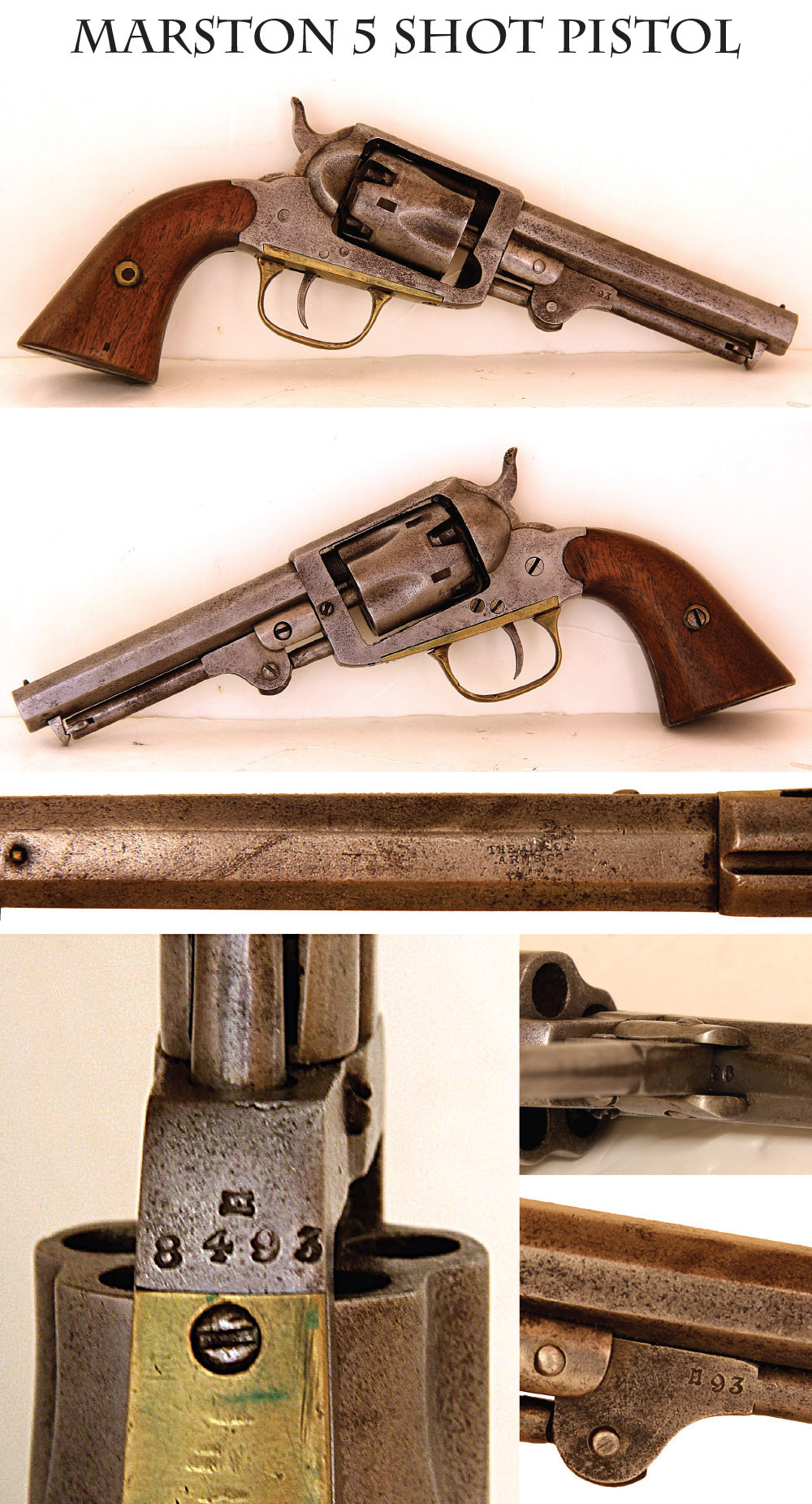
13-11-11 … Marston Pocket Revolver.
13-11-11 … 31 caliber 4.25 inch barrel looks like a Whitney pocket Barrel marked The Union Arms Co. VG condition. Ca 1860. All original and complete
… $650.00 SOLD
Click Here to E-mail Us!
Call us @ 419-842-1863

13-11-12 … Revised Regulations for the Army of the United States.
Nice copy of the 1861 army regulations officially adopted in August, 1861, published by Lippincott, Philadelphia. Gilt embossed blue cloth covers in very good condition. If you ever wanted to know what made the army run, here is the book. No officer could afford to be ignorant of its contents and it guided his every action on a daily basis from matters of rank, duty and uniform to the multitude of forms and reports he would be required to fill out every day. Along with the Caseys Tactics and the Kautz Customs of Service volumes I offer below, this is a key volume in understanding the Civil War army and a key possession of any Yankee officer.
… $195.00 SOLD
Click Here to E-mail Us!
Call us @ 419-842-1863

13-11-13 … Smith and Wesson Model No. 3: A Real Western Cowboy Gun Identified to the Cowpoke by his Moniker, Squirt!
Smith and Wessons were the big competitors to Colt in the American West and many preferred them for their durability, speed and ease of loading with the top break system, and automatic ejection of spent shells, etc. They are frequently referenced and a number of western personalities owned them. Annie Oakley owned several. It also helped to have a lower hammer profile if you needed to pull it from a pocket quickly: Jesse James supposedly gave one to Bob Ford, who in turn tried it out on him while he was straightening a picture in his parlor. This is a very nice example with excellent condition checkered hard-rubber grips and nice color. The grips have a sharp Smith and Wesson logo impressed at the top of each side and wonderful detail with no chipping. The correct single line barrel address appears on the top of the barrel and the S&W logo appears again on the right side of the frame. Serial number 33688. All frames for this model were made before 1898. The barrel address has no patent dates, which is correct for this serial number range. Sharp edges to the metal and a good tight fit to all parts, the original blue has shifted to a light plum-brown overall with some blue evident just forward and aft of the cylinder. Nice areas of case color are visible on the hammer. Mechanically very good though the ejector is hit or miss.
The coolest thing about this gun is that the owner personalized it with his nickname in several spots. Once on top of the barrel and twice underneath is stamped the nickname SQUIRT. Like soldiers in the Civil War, Cowboys were fond of nicknames and this one seems fully appropriate to a young cowboy who would have to prove himself to the more experienced hands, which apparently he did, because he not only wasnt ashamed of the moniker but proudly used it to identify his sidearm. 1-7/16 cylinder in 44 Russuian caliber. We dont often get to shake hands with a real westerner, but this gun has everything going for it to indicate it was really there in the days of the Hole in the Wall Gang and the final decades of the old west.
… $1,150.00 SOLD
Click Here to E-mail Us!
Call us @ 419-842-1863

13-11-14 … Confederate Richmond Rifle Musket:
The real deal — a totally honest “Richmond” that is 100% “Richmond” from muzzle to butt plate… except for the crude ramrod which is either a CS replacement or a hillbilly replacement. This old war horse shows plenty of wear and use… but no abuse and no modern repairs or cobbles. Has proper brass butt plate, brass nose cap, straight ramrod channel, etc… etc… etc… The lock is marked 1862 behind the hammer and CS Richmond Va. ahead of the hammer. The rear sight is the proper Richmond version of the 1855 short range pattern and it has been slightly shortened along the front (forward) end. The barrel proofs are visible but worn. The barrel date is completely worn away. All steel surfaces are a mixture of gun-metal grey and smoky patina with light rust pitting over 60%. The stock shows plenty of handling and wear. It is full length, unbroken, and unaltered. Both sling swivels are present. The bore is good with decent well-worn rifling. I would judge this musket to have been produced late in 1862 due to the fact that ALL the parts are Richmond made, with no US “leftovers” in the recipe. Early Richmonds utilized captured US parts from Harpers Ferry. Later war Richmonds utilized US parts captured from prisoners guns or picked up off battlefields. It is the mid-war Richmonds that are most desirable as they are generally “purer” Richmond. If you are looking for a
REAL RICHMOND RIFLE MUSKET
… here she is
… $5,900.00 SOLD
Click Here to E-mail Us!
Call us @ 419-842-1863
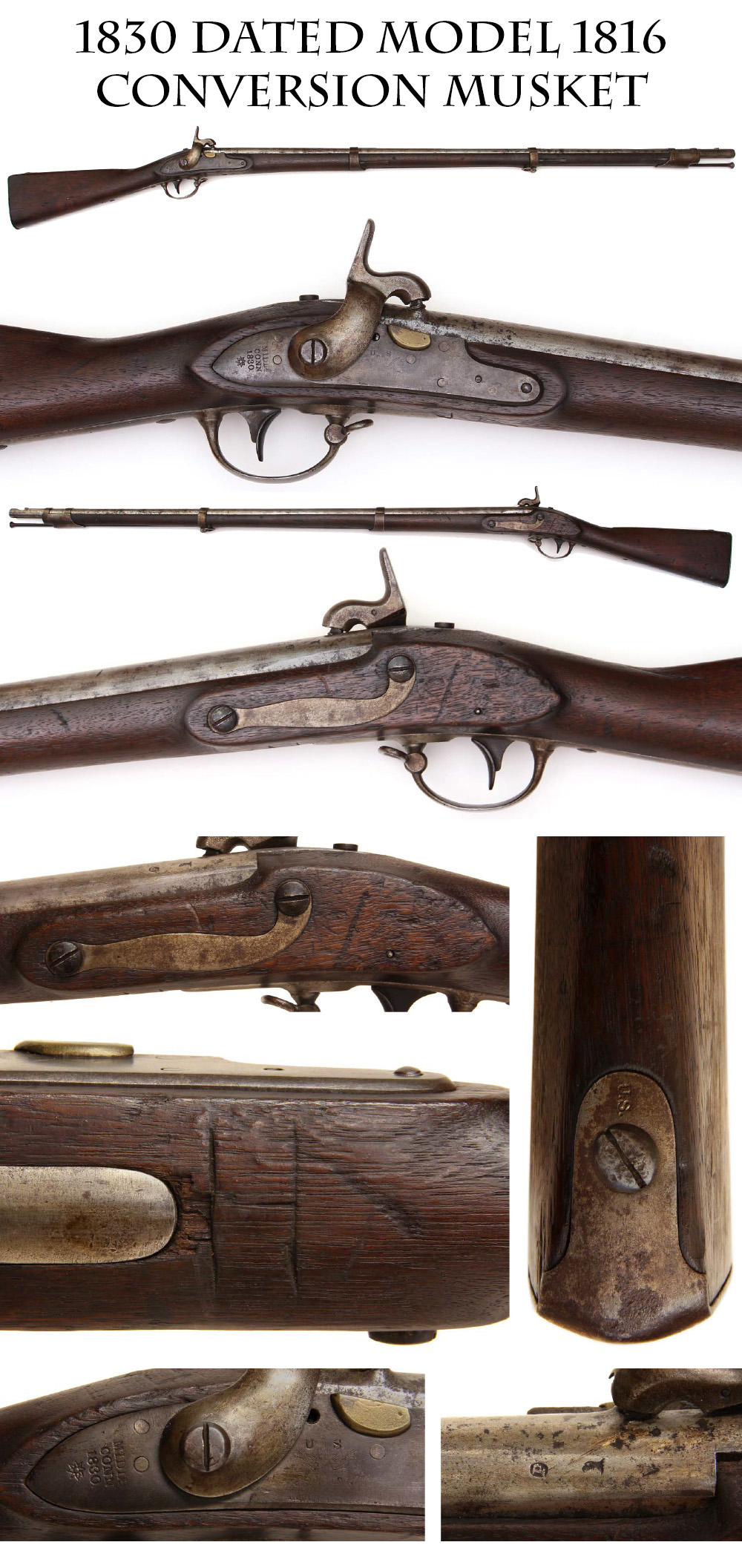
13-11-15 … Nathan Starr 1816 Pattern Musket dated 1830,
with an arsenal percussion conversion. Few American arms makers are better known than Starr, who had a wide variety of US contracts for muskets, pistols, sabers, and cutlasses over a long period. Here is a solid example of his 1816 Pattern Type 3 flintlock with the “cone-in-barrel” or “Belgian” style conversion favored by US arsenals. Starr made some 15,000 of these muskets between 1829 and 1840. This is one of the earliest versions, second year, and bears the 8-pointed star or floral motif at rear of the lock behind “MIDDtn/ CONN/1830.” Forward of the hammer is the standard small US over a sunburst and N. Starr. The lower portion of the sunburst and the Starr name are rubbed as is often the case when the arsenal ground down the brass flash pan and added a military percussion hammer. The US mark is sharp. Clear eagle head and sunken “P” proofmarks on the left barrel near breach. Good strong edges on wood around lock and a good butt stock and fore stock. Some wood dings opposite the lock, very minor chips to edge of triggerguard tang on underside and a carved letter “H” from a previous owner or soldier. Lock plate shows cloudy gray of faded case color, barrel is dull silver with rising brown areas, but smooth overall with just a couple of corrosion dimples near the nipple from firing. Correct swivels, ramrod, barrel bands and springs, mechanics good. After the percussion system was adopted by the U.S. government flintlock arms held by arsenals were divided into classes by age and condition and the newest and best condition guns were converted to the new system by several methods. The cone-in-barrel style was the one favored by the arsenals. These became the weapons issued to volunteers in the early years of the Civil War as the army expanded and new production could not keep up. This gun has surely seen some good history, a pre-Alamo and Seminole War musket that later found its way into the ranks of the north or south, in 1861. Very good to near fine condition. 100% original, 100% complete, and mechanically perfect. A very affordable musket from America’s early days
… $895.00 SOLD
Click Here to E-mail Us!
Call us @ 419-842-1863

13-11-16 … Full Set of Caseys Infantry Tactics Identified to a Maine Colonel Who Commanded the Regiment at First Bull Run.
All three pocket-sized volumes complete with fold-out plates, etc., published by Van Nostrand, New York, 1862. These were official infantry tactics of the Union Army and were kept on hand by officers of all ranks. They start off with the school of the soldier, giving basic instruction to individual soldiers in Volume 1 and progress through the school of the company and even up to brigade and higher levels in the subsequent volumes. These are a key source for any Civil War collector or student in understanding battlefield and campaign maneuvers and the organization and deployment of Civil War companies, regiments, etc., just as they were for officers and aspiring officers during the war. Casey had been in charge of provisional brigades and divisions of troops outside Washington in 1861, giving them basic instruction before sending them forward to forward camps in Virginia. He made use of various foreign manuals and those of Scott and Hardee as well as his own experience in forging a workable system for the new armies of volunteer troops summoned to defend the Union and it was officially adopted as of August, 1862.
Inscribed inside the front cover of each is, Col. M.H. Dunnell/ 5th Maine Vol./ Camp Preble/ Portland Maine (a son or other relative Warren Dunnell/ Portland / Me. later added his own name to the flyleaf.) Mark Hill Dunnell was a Maine politician and lawyer who was appointed first Colonel of the Fifth Maine. While recruiting in the wake of Fort Sumter, Colonel Mark Hill Dunnell was the first commander of the regiment, which was mustered into the service of the United States on June 24, 1861, and left for Washington, DC, just two days later. It was stationed at Meridian Hill until it joined the advance in early July toward Bull Run, where it suffered a grueling march as part of Howards Brigade and then fought in the battle of July 21 where it lost 35 men killed, wounded and prisoner according to CWData. The battle was far from a triumph for Union forces, but the regimental historian thought Col. Dunnell had done his duty: at the Battle of Bull Run, Colonel Dunnell was present with his command, led them into the action as well as any officer could have done with no more practical experience, gave his orders as cooly and deliberately as any man could do, nor did he issue the order to retreat, until he received it from his superior officer. On the retreat it was impossible to make any rally of men; and while hundreds were hurrying past him, he was calm, as upon the advance. He showed himself brave, self-possessed, and willing to do everything he could with his command.
Col. Dunnell left the regiment August 28, 1861, his resignation was accepted and he mustered out, but his training must have done well by the regiment- during their subsequent service they fought well at Gaines Mill, Cramptons Gap, Chancellorsville, Rappahannock Station and Spottsylvania, among other bloody fields, captured six enemy battleflags and ended up taking more enemy prisoners than they had men in the ranks. Upon leaving the service Dunnell was appointed US Consul at Vera Cruz, Mexico, for 1861 and 1862. Camp Preble at Portland, next to Fort Preble, was a point of rendezvous for Maine troops. It seems likely, given the publication dates of the volumes, that Dunnell served there after his return to Maine, using his regimental affiliation and rank even though he had officially left the regiment. After the war Dunnell moved to Minnesota, where he continued his political career, spending several terms in Congress, and died in 1904. Even without the personal identification, this is a tough set to find complete. Full set
… $385.00 SOLD
Click Here to E-mail Us!
Call us @ 419-842-1863
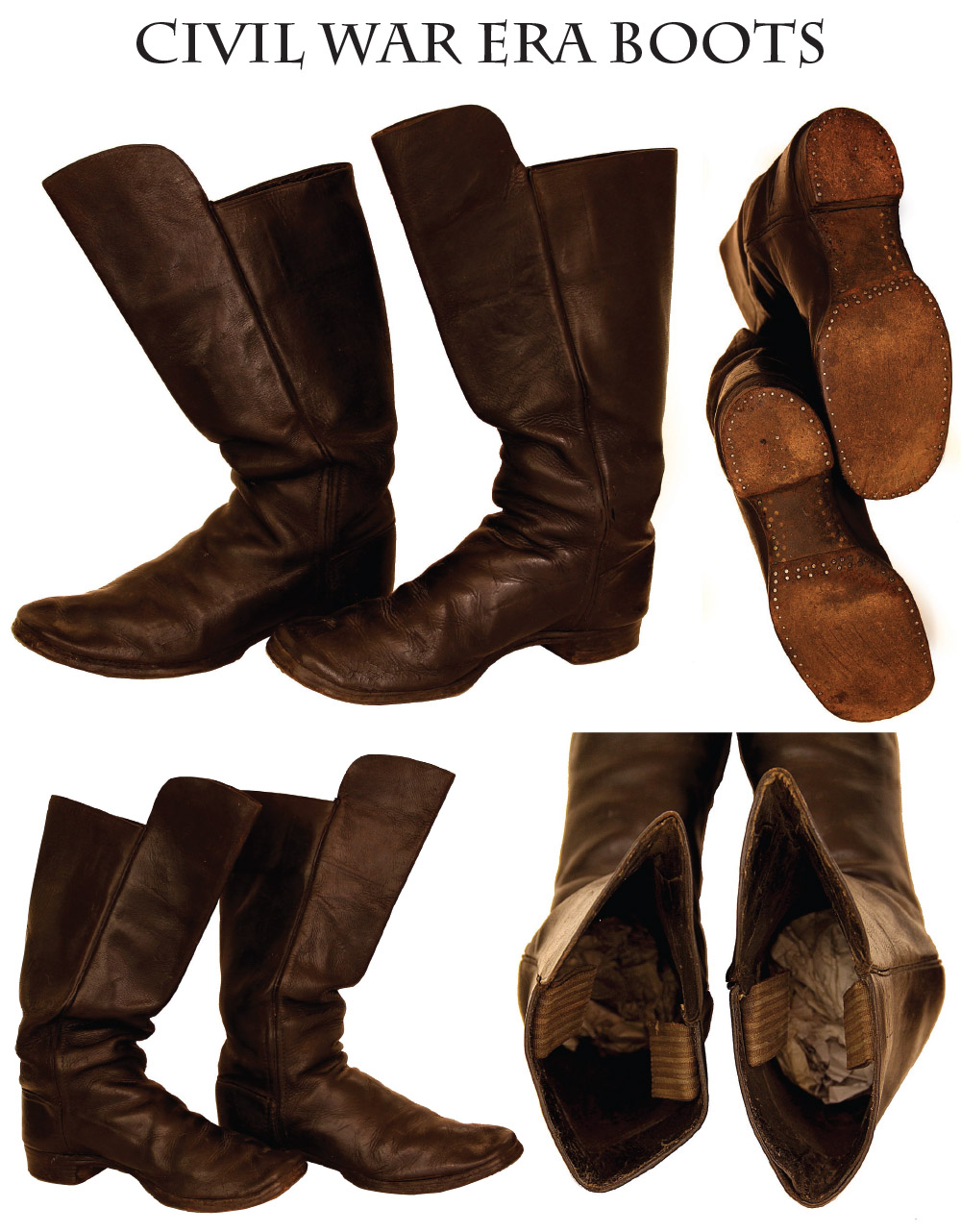
13-11-17 … Super Condition and Top Style High Knee Flap Civil War Era Boots.
Excellent condition pair of CW era boots with characteristic high flap fronts that we like to see and good square toes. Boots have interior canvas loop pulls, and the soles are fastened with a combination of pegs and nails. These are certainly privately purchased and show some nicer details such as a lining inside the knee flap. We see photos and sketches of both officer and enlistedmen wearing this style. I have always thought they look great displayed with cavalry gear. Of course some infantrymen wore them, particularly in bad weather, but I have to say they would look especially good next to the Colt pistol ammo crate I offer in this list as well.
… $495.00 SOLD
Click Here to E-mail Us!
Call us @ 419-842-1863
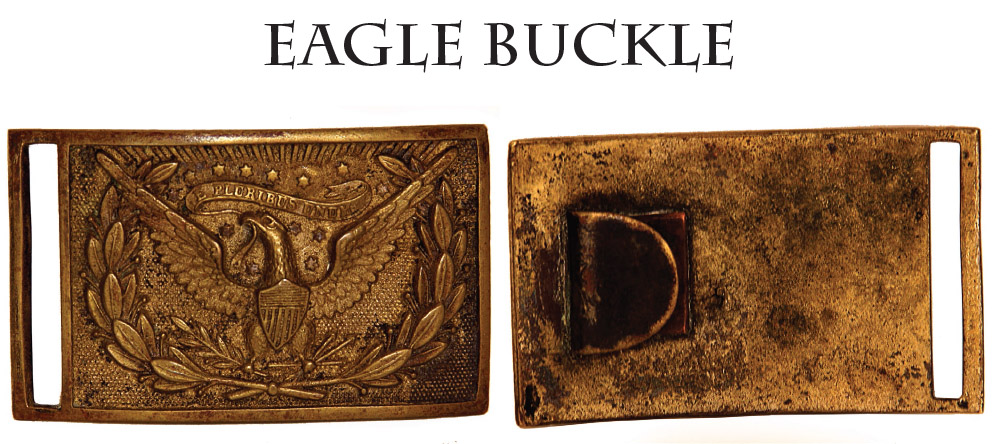
13-11-18 … Wonderful Field Repaired Officers Buckle: Standard CW eagle buckle.
Medium width tongue on the reverse is unquestionably a period field replacement. Officers on both sides wore these 1851 pattern plates. The replaced tongue certainly lends itself to the possibility of a CS repair.
Great buckle
… $285.00 SOLD
Click Here to E-mail Us!
Call us @ 419-842-1863

13-11-19 … CDV J.D. Greene: In the Wheatfield at Gettysburg!
Lt. Col. James Durrell Greene, Commander of the 17th US Infantry in the Wheatfield at Gettysburg, and Firearms Inventor of the First Bolt Action Rifle Adopted by US Ordnance The famed Greene Bolt Action. Very clear full standing carte-de-visite view of Greene posed next to a column in the photographers studio, wearing a kepi with rain cover, a field grade officers frock coat, holding the pommel of cavalry saber with officers sword knot and wearing a waistbelt with a round two-piece buckle, certainly a Massachusetts state plate. Silsbee, Case & Co. Boston backmark. Greene had a life-long interest in the military and firearms. Born in 1823, he had hoped to attend West Point, but was blocked by his mother, whose brother had died there as a cadet. He attended Harvard instead, but used his time to develop a firearms system that he patented in 1854 and used in the Greene breech loading carbine, manufactured in Massachusetts, small quantities of which were purchased by the US and British governments in the 1850s. At the outbreak of the war Greene was Lieutenant Colonel of the 5th Mass. Militia and accepted an appointment at that rank to the 17th US Infantry May 14, 1861, when Lincoln expanded the regular army. (It is a surprising coincidence that he spent much of his early time in the US Army at Fort Preble in Maine, where Col. Dunnell of the 5th Maine signed the Caseys infantry tactics I offer elsewhere in this list.) In any case, Greene got tired of sitting out the war and changed places with the regiments major in time to command the regiment in July, 1863, at Gettysburg! As part of the Fifth Corps the regiment was rushed forward on the left to shore up the collapsing Union line in the area of the Wheatfield and suffered heavy casualties (24 killed and 125 wounded) in the fierce fighting with Longstreets divisions of Hood and McLaws who were striving to roll up the Union flank. Greene was subsequently promoted to Colonel and given command of the 6th US Infantry Sept. 20, 1863, and later served as Acting Assistant Provost Marshal General in Madison, Wisconsin. He was one of the March 65 brevets, being made a Brevet Brigadier General for gallant and meritorious service in the war, finally resigning from the army in 1867.
Greenes carbines are well known among collectors, but his greater claim to fame is perhaps his invention of the first bolt-action rifle adopted by US Ordnance. He patented a system in 1857 that used a bolt action to permit breechloading the rifle, but still required a percussion cap primer for the cartridge. The lock was an underhammer design and the bolt had to be operated twice to seat a cartridge with a bullet in its base intended to act as a gas check for one in the barrel and then be seated in its place for the next round. Needless to say, the system was a little too complicated to be practical and widely adopted. Greene apparently used some political influence to get Massachusetts to purchase some and the US to purchase 900, but they were not a huge success, and aside from some 3,000 sold to Russia, private sales and sales to militia units were apparently sparse. He never gave up his interest in arms, however, and his name appears on an 1885 patent application for a magazine system. He apparently suffered from paralysis in later life that he developed drumming up business in Britain, and died in Ypsilanti, Michigan, in 1902.
A very interesting figure in the history of US firearms with a significant combat record to boot.
… $395.00 SOLD
Click Here to E-mail Us!
Call us @ 419-842-1863

13-11-20 … Near Perfect 1863 Artillery Bit:
The pictures tell the story. Both US bosses are beautiful. This piece is in superb condition, great markings.
… $195.00 SOLD
Click Here to E-mail Us!
Call us @ 419-842-1863
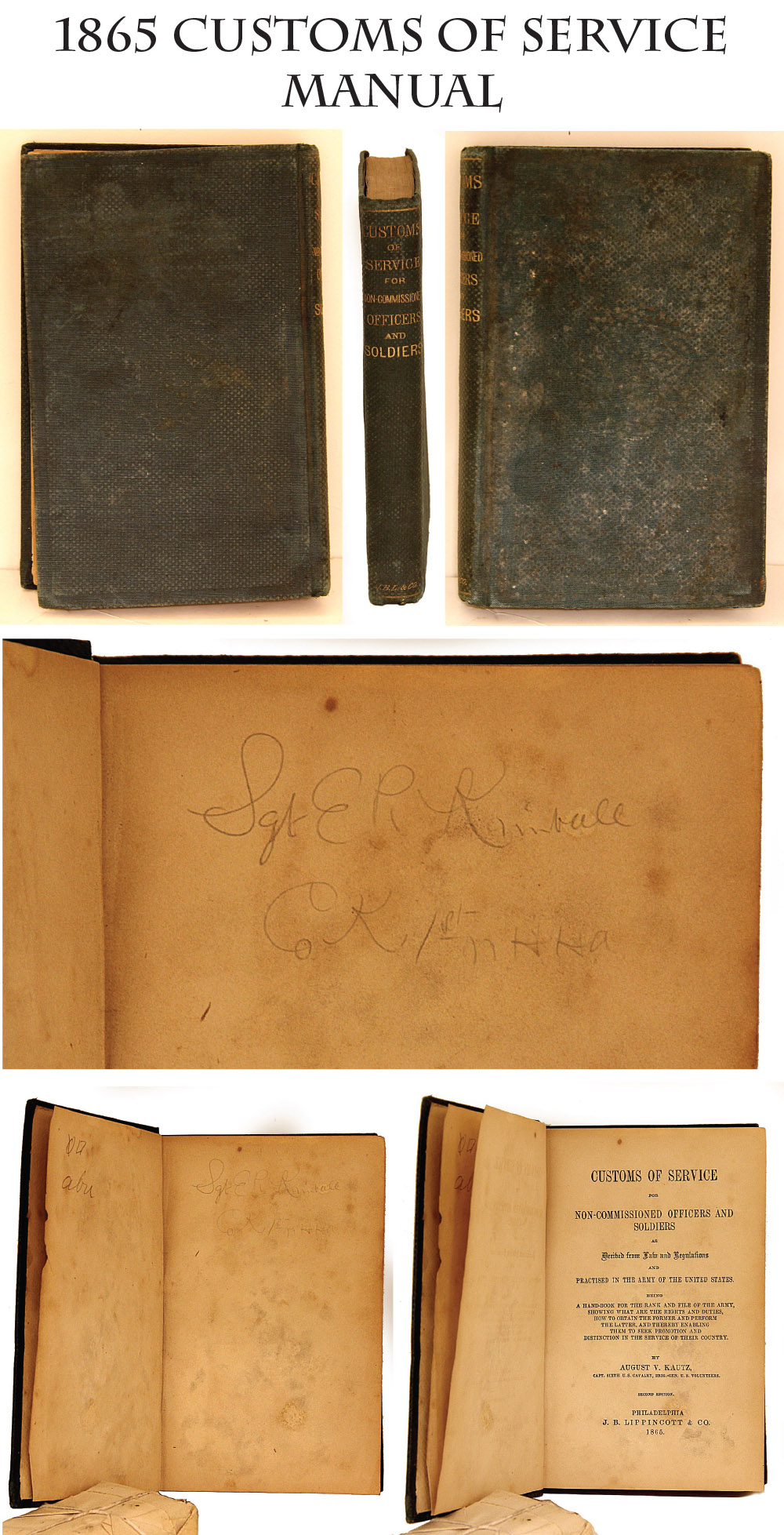
13-11-21 … Very Very Rare Manual for Non-Commissioned Officers – Signed:
the Inner Workings of the Army. A scarce, and essential manual in fact the first and ONLY copy I have ever owned: Customs of Service for Non-commissioned Officers and Soldiers, by August Kautz, Lippincott, Philadelphia, 1865. This is a very interesting manual that falls under the heading of everything you need to know, but were afraid to ask about the duties of various NCOs: the various company sergeants and corporals, but also the equally important Quartermaster and Commissary Sergeants who were key figures in the running of the army. This particular volume is signed on the flyleaf: Sgt. E.R. Kimball / Co. K 1st NHHA Kimball originally signed up at age 20 as a sergeant in a 3-month infantry unit 7/25/64, but joined the 1st NH Heavy Artillery 9/16/64 and mustered in the next day as a sergeant in Co. K. He served with them until mustered out 6/15/64. During his service the regiment served in the 22nd Corps in the forts around Washington, sometimes manning picket lines as well as the fortifications, and one company served as a light battery with the Second Corps in the field. Kimball was obviously interested in learning his duties and the manual provides a valuable inside look at the US military of the time. Arguably the rarest US manual I have owned.
… $350.00 SOLD
Click Here to E-mail Us!
Call us @ 419-842-1863
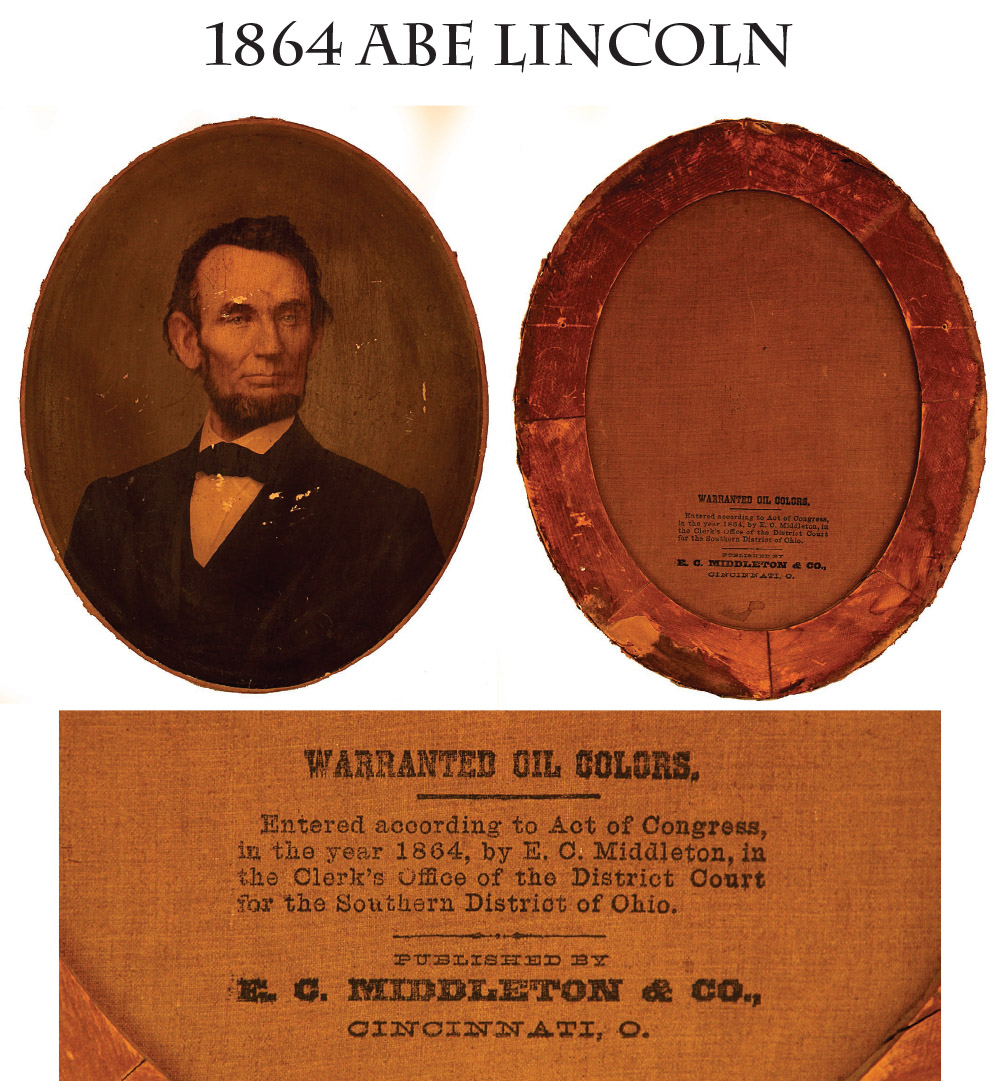
13-11-22 … E.C. Middleton Chromograph of Lincoln circa 1864:
The Middleton company of Cincinnati produced a variety of these oil paint lithos of various Civil War and historical figures. This 17 x 14 example of Lincoln is one of the most sought. Elijah C. Middleton established his engraving firm in Cincinnati in the mid-nineteenth-century with his partner, W.R. Wallace. Shortly after Hines Strobridge joined Middleton and Wallace in partnership, Middleton struck out on his own in 1861 as a “Portrait Publisher,” advertising his own gallery of printed portraits made with “warranted oil-colors.” His finely-rendered portrait of George Washington (see below) became an early icon in the world of chromolithography. Desiring an accurate representation of Abraham Lincoln, Middleton actually solicited the President’s advice, sending a proof copy of the print and receiving in return a letter from Lincoln with both compliment and critique. The resulting portrait is the only instance in which Lincoln is known to have advised the artist for one of his portraits. The Lincoln print was popular enough that it was reissued by Thomas Bising and Herman Gerlach when they took over Middleton’s firm around 1867. This is an early Middleton portrait of Lincoln produced during Lincolns lifetime. Condition is about very good with some minor scrapes and chips. No frame. Very desirable.
… $295.00 SOLD
Click Here to E-mail Us!
Call us @ 419-842-1863
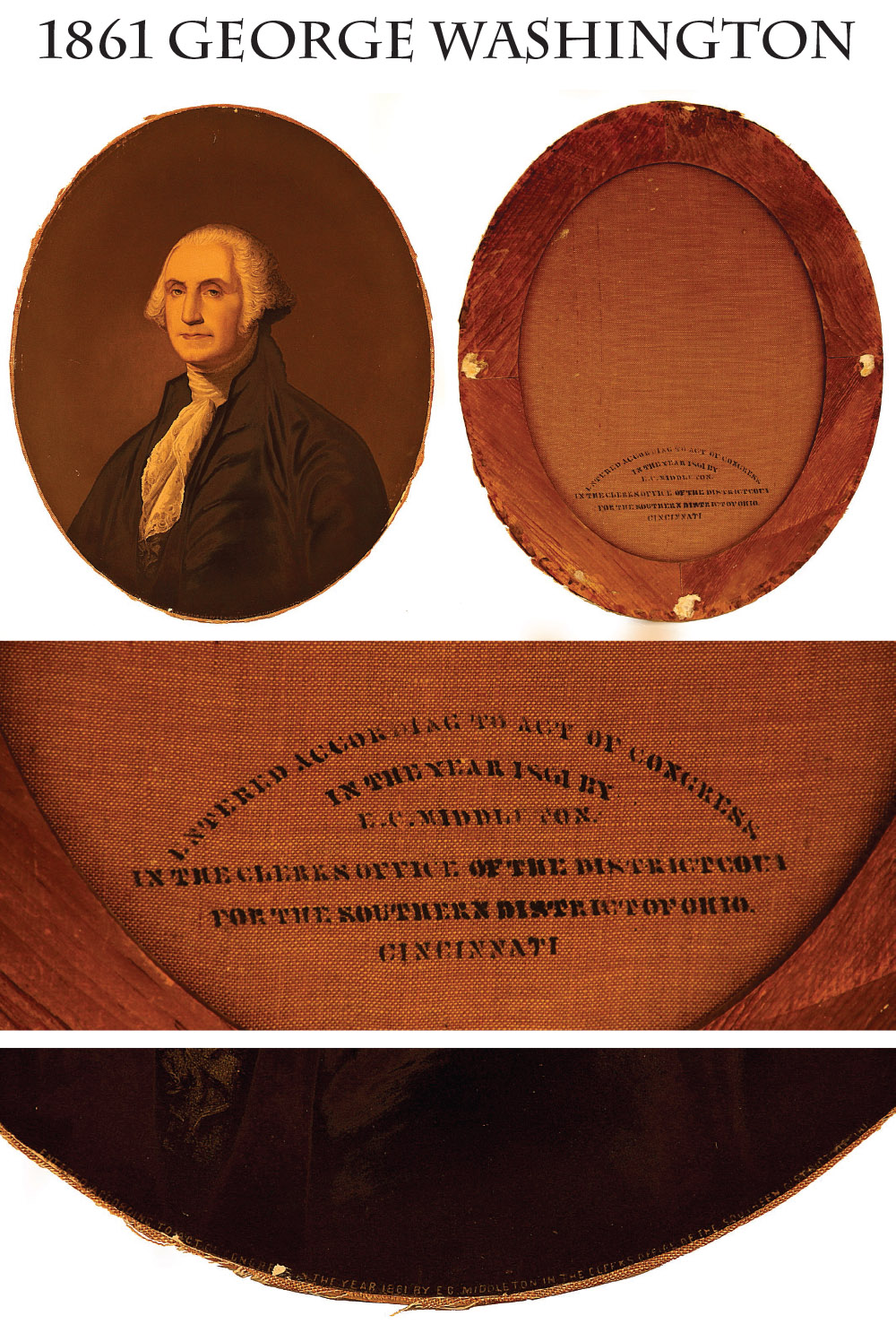

13-11-23 and 13-11-24 … George & Martha Washington Middleton Lithos.
As referenced above here are the Washington Lithos. 17 x 14 Very folky representation of the father of our country giving it that real period flavor. Near perfect condition … priced for the pair at
… $395.00 SOLD
Click Here to E-mail Us!
Call us @ 419-842-1863
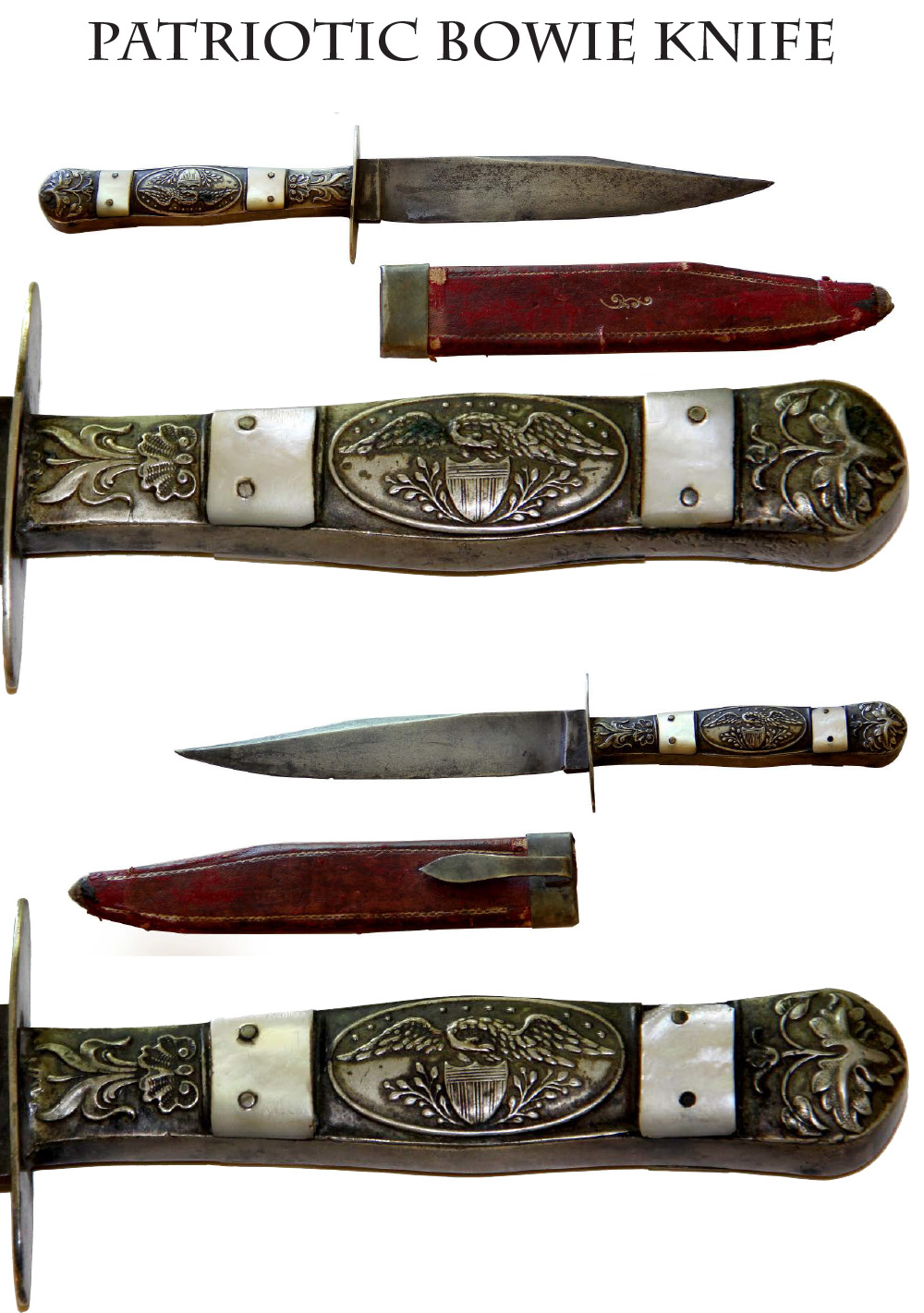
13-11-25 … Patriotic Bowie Knife with Original Red Scabbard.
Silver panel embossed grips with mother of pearl insets. The upper and lower sections are floral designs. The central panel on each side has a wonderful spread-winged US eagle curling its neck over a US shield with branches spreading below and a row of stars over the eagle. Nice untouched muted color to the silver. Oval German silver guard. Classic Bowie blade with false back edge. One minor nick on the edge, otherwise very nice. Untouched, uncleaned blade a dull silver also, with some graying and a smattering of dark spots. Unmarked ricasso. Original red leather or leatherette scabbard, with gilt embossed border decoration and a central flourish on one side. German silver throat in place with flat belt hook. Small metal tip is long gone, but the scabbard extends almost to the point. A very nice bowie of good form, excellent for an early western display or military display. The knife measures 10 3/4″ in length, with a 6″ blade. A classic Union Army soldiers knife
… $1950.00
Click Here to E-mail Us!
Call us @ 419-842-1863
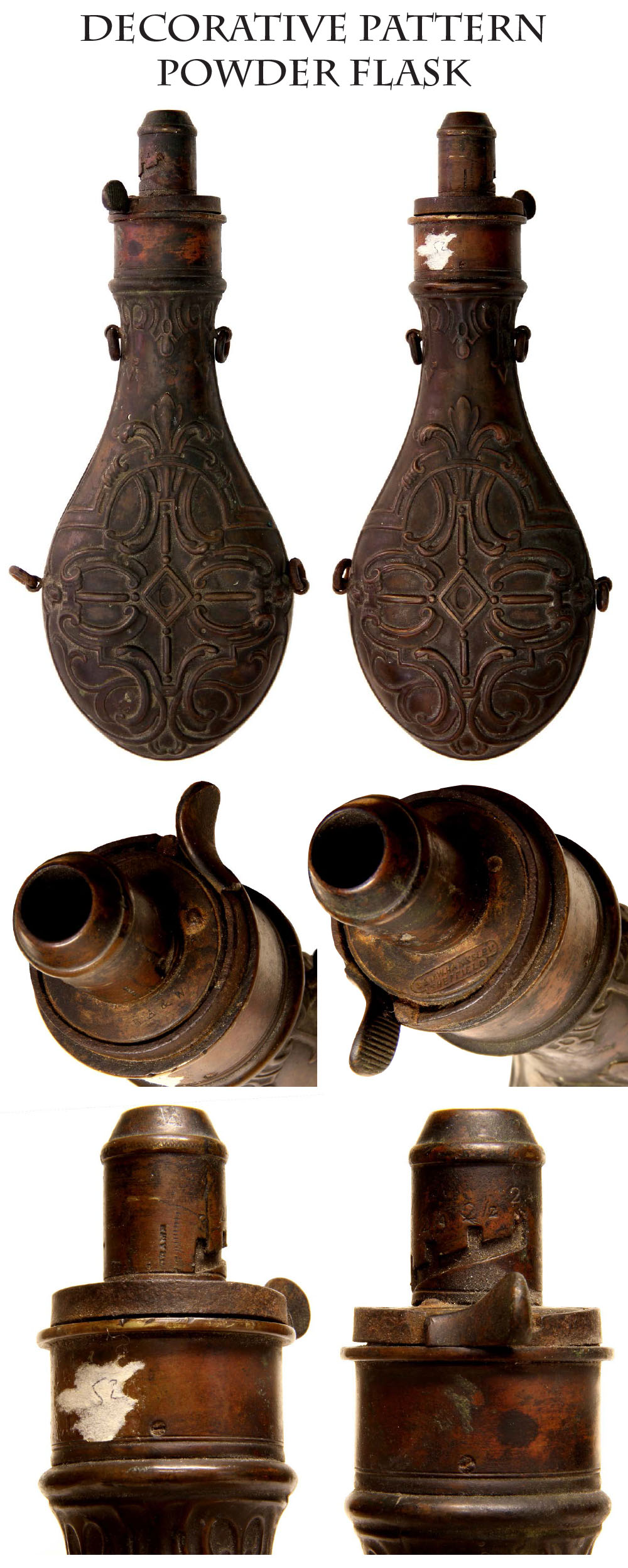
13-11-27 … Decorative Pattern Powder Flask:
Measures 8 1/4 inches long including the spout, and has ornate details on both sides of the body. Base of spout has markings “G & J.W. Hawksley Sheffield” as well as “B.A. & W”. Neck has an old inventory number “52”.
It has some age to it but a fine condition flask overall
… $95.00 SOLD
Click Here to E-mail Us!
Call us @ 419-842-1863
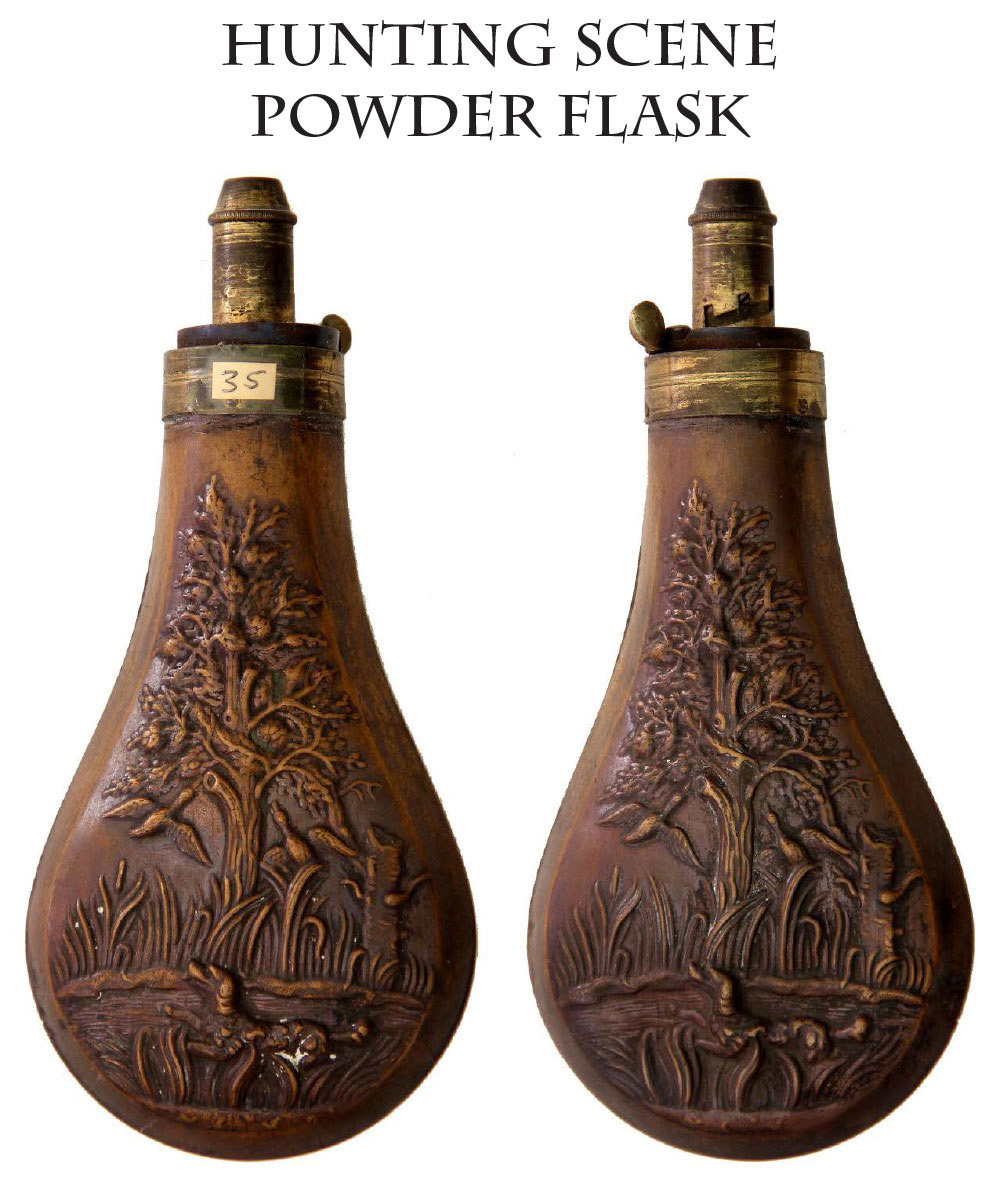
13-11-28 … Hunting Scene Powder Flask:
Measures 7 1/2 inches long including the spout, and has a detailed hunting scene on both sides of the copper body. Neck has an old inventory number “35”. Has minor dents to body as well as some patina. Overall this makes for a decent condition powder flask
… $95.00 SOLD
Click Here to E-mail Us!
Call us @ 419-842-1863
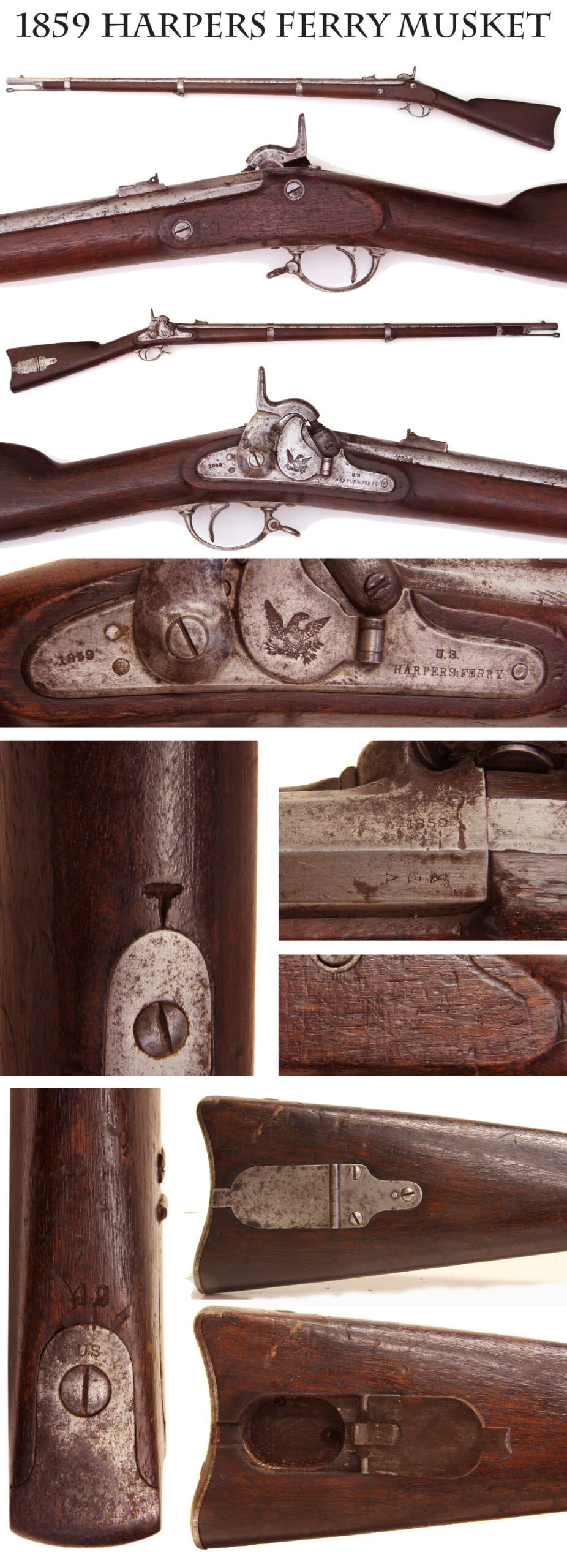
13-11-31 … Extremely Scarce
M-1855 Harpers Ferry “Patchbox” Rifle Musket:
Among the Holy Grails of Civil War longarms are these Harpers Ferry ’55 rifle muskets with the Maynard tape primer system. The reason being … this is the arm that was on hand when the Confederates captured the arsenal in 1861, and many, if not most of them, wound up in the hands of the Johnny Rebs. And those that were not captured by the rebs had likely been issued to US Regulars who were already in the field when the war broke out. The Springfield examples are very desirable, the Harpers Ferry examples are ultra desirable. This gun is totally original and complete and is also mechanically perfect. Metal is overall gun-metal grey with vivid sharp markings and some age staining and areas of light pitting. The lock date and barrel date are matched “1859 Stock edges are very good++ and “JS” cartouche is partially visible. The rear sight is the proper short range pattern found on the “patchbox models” of the ’55. The bore is about VG. This is a totally original and honest Harpers Ferry ’55. It is 100% original, 100% complete, and mechanically perfect. Proper in every way for an early war Confederate display.
… $3500.00 SOLD
Click Here to E-mail Us!
Call us @ 419-842-1863
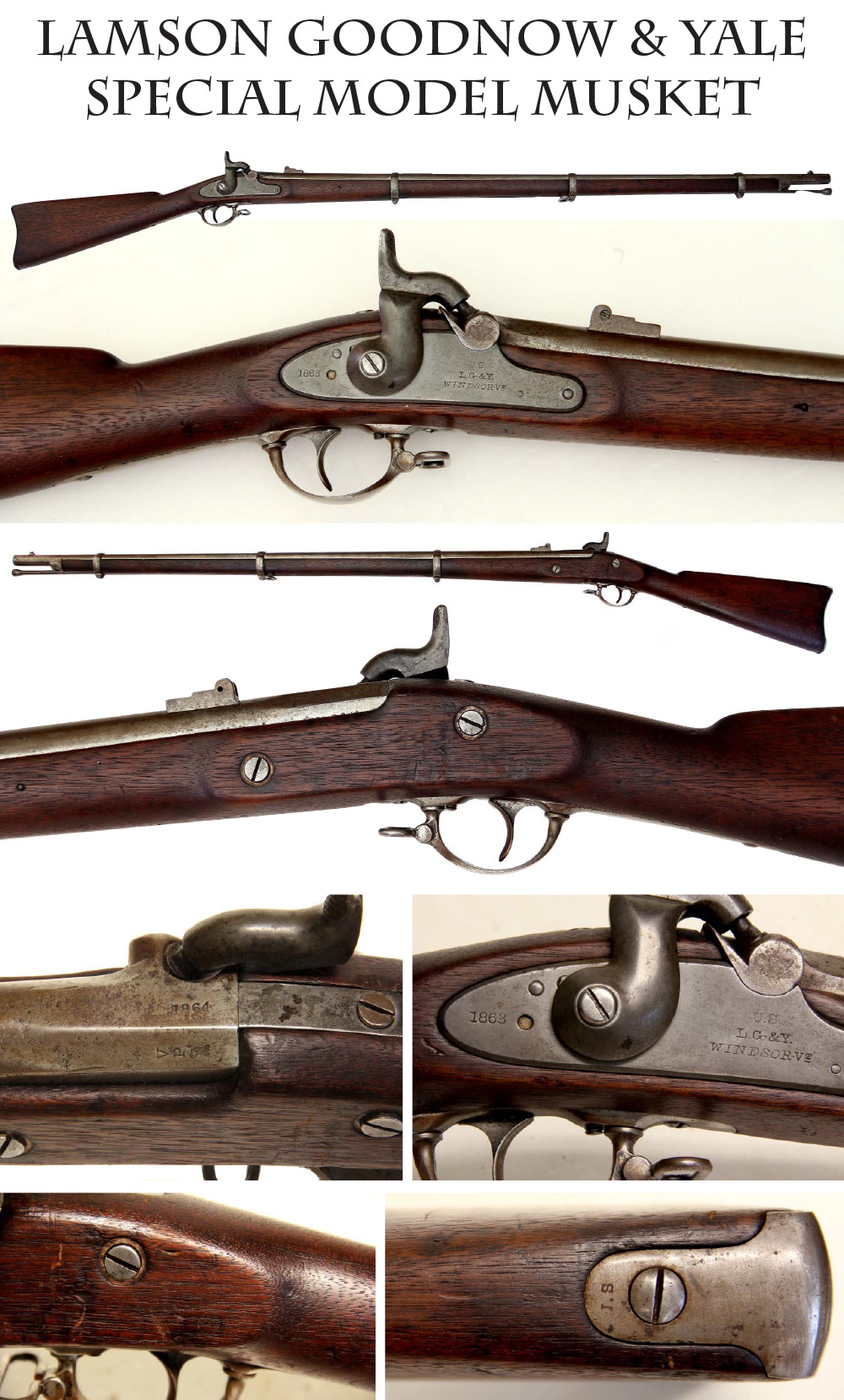
13-11-32 … Lamson, Goodnow and Yale Special Model 1861 Rifle Musket.
These Special Model 1861 rifle-muskets were very similar to the 1863 Springfields and were produced only by Colt, Lamson Goodnow & Yale, and Amoskeag. The hammer configuration is the most obvious change like a 63 style, and the use of split barrel bands without springs are likewise as on the 63 Springfields. The lock is clearly marked US over L.G.&Y. over Windsor Vt. forward of the hammer and 1863 to the rear. Eagle on bolster. Barrel has clear VP/eagle proofs on left barrel flat and clear 1864 date on top of barrel near breach indicating assembly in early 1864 using a lock plate made at the end of 1863 (one year differences in date stampings are totally acceptabled, a plate made in December 1863, can be assembled with a barrel made in January 1864 unlike a two year spread in dates where Lucy might have some splainin to do. Wood rates vg+ with no chips, dings or splits, just some rounding of edges from handling and use. Cartouches are still visible on the offside. Very slight shrinkage at edge of buttplate tang. These were finished in the bright and the smooth metal retains a lot of it below some surface brown spots. 100% proper with correct second type rear sight, original front sight firmly in place, correct barrel bands, swivels, and correct ramrod. Lockplate and hammer show signs of case color that has shifted toward a smoky hue. Mechanically perfect, VG bore. This is a nice midwar gun in very good condition and a variant
… $1,495.00
Click Here to E-mail Us!
Call us @ 419-842-1863
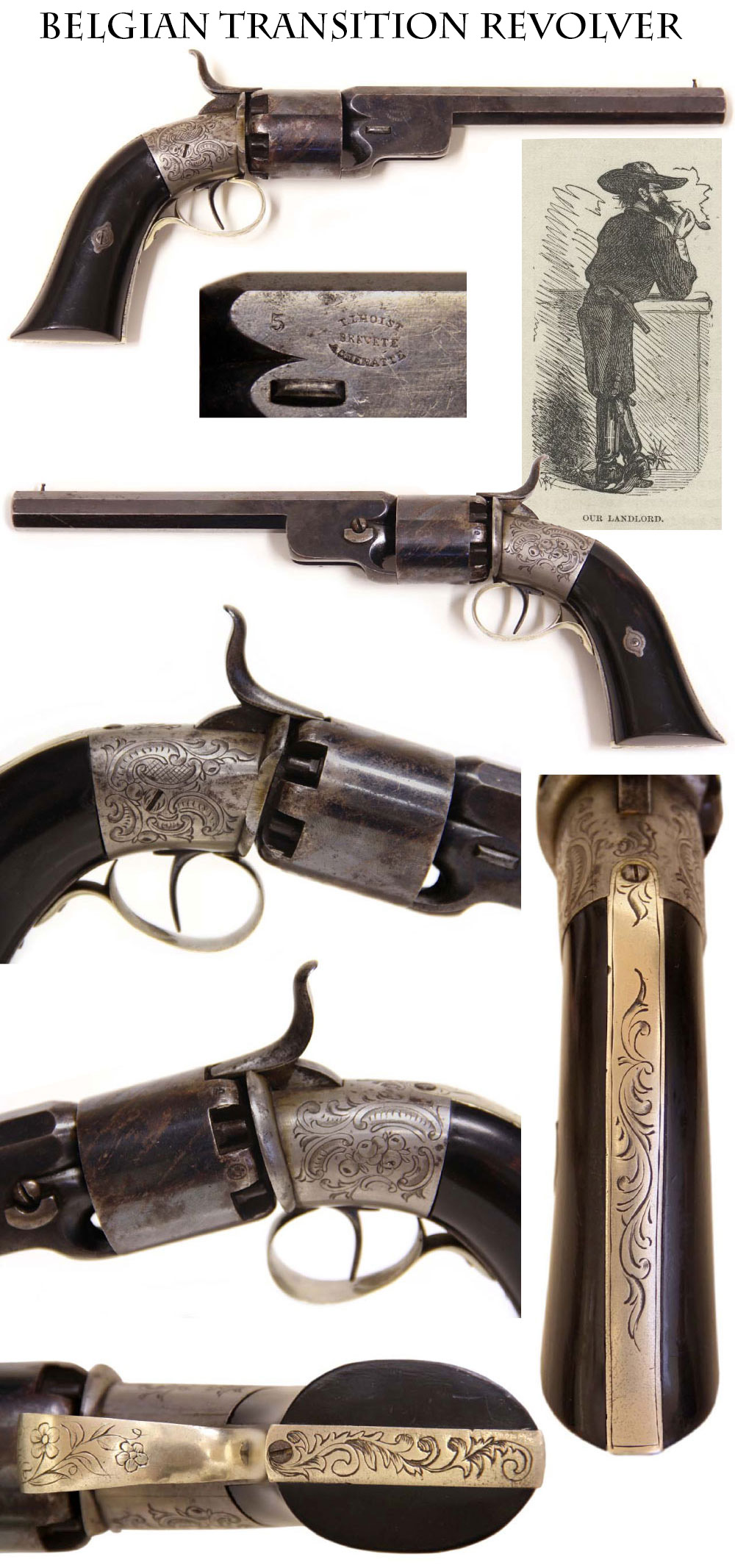
13-11-33 … Extra Fine – High Finish – Engraved – Belgian Transition Revolver:
From the standpoint of condition, quality, and form this is one of the finest guns I have owned. When I found it for sale while visiting in Colorado I couldnt get my wallet open fast enough. The 6.5 inch barrel exhibits 98% vivid factory blue. The cylinder has nearly that much just showing slightly more wear. The silvered frame, trigger guard, back strap, and butt strap are magnificently hand engraved with floral and foliate scrolls. There is even a bunch of apples or peaches engraved on the left frame. Bore is roughly .40 caliber or so … Right side of barrel lug signed T.L. Hoist / Brevette / Cheratte These transition revolvers are so named because they are a transition in arms technology from the pepperbox design to the modern revolver design. There are dozens of variations on them, usually English and western European. This has the frame, and mechanical design of a pepperbox, but the hammer, grip, cylinder and barrel are like the early style Colts. This is roughly the size of a Colt Navy revolver. Top shelf in all respects.
A truly high quality antique arm
… $2,500.00 SOLD
Click Here to E-mail Us!
Call us @ 419-842-1863
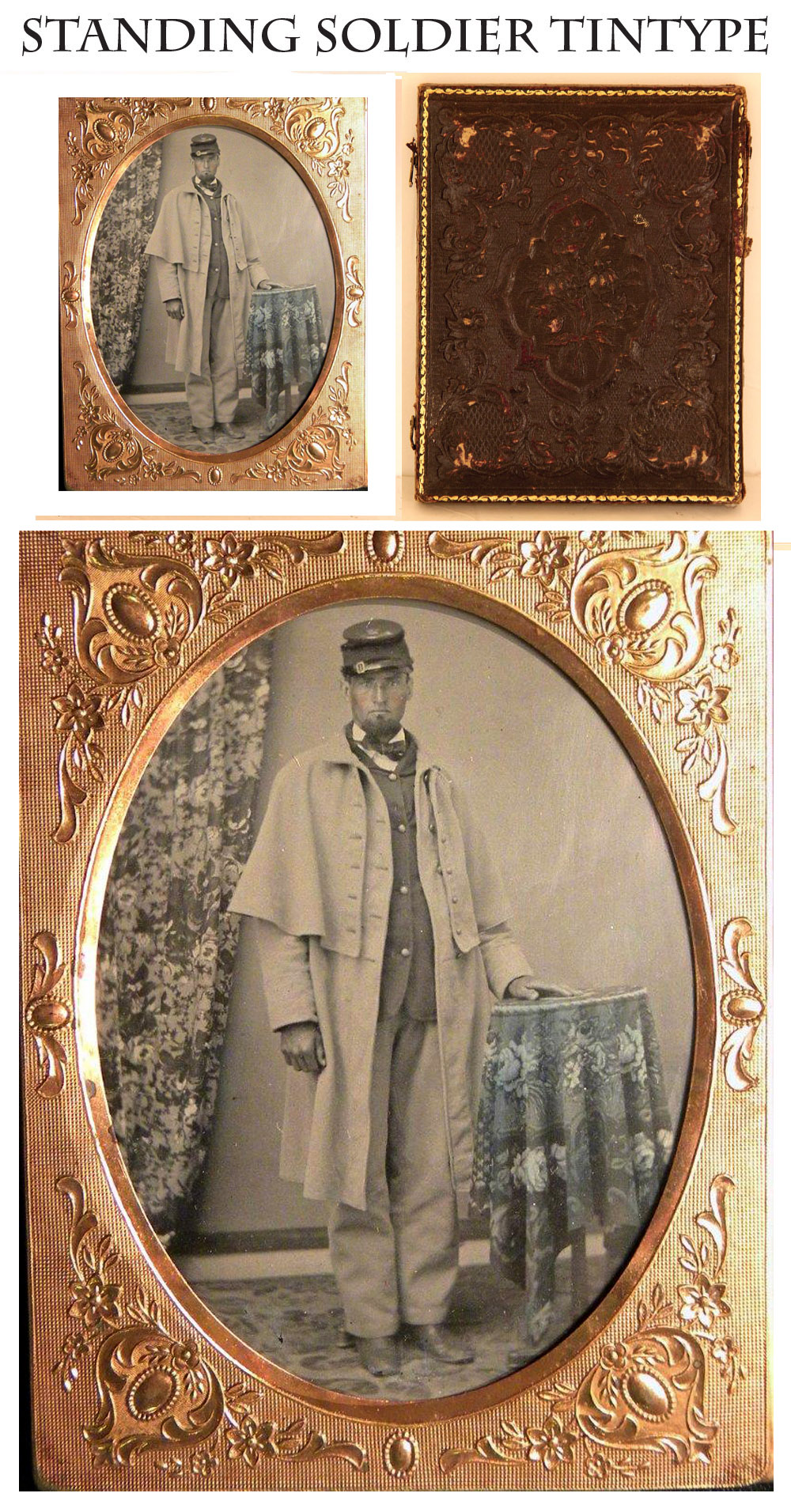
13-11-37 … Superb Quarter Plate Ambrotype Union Soldier … VIVID!
Top notch image … bright and sharp among the best you can find, and the scarce large quarter plate size too 4.25 x 3.5 inches. Yank wears infantry greatcoat, 4-button blouse, and forage cap. So clear you can see him breathing. Superb image. Housed in a leatherette case (no lid)
… $285.00 SOLD
Click Here to E-mail Us!
Call us @ 419-842-1863

13-11-38 … Tired and Well Used Colt Vest Pocket Revolver.
Good to VG. Great for wild west cowboy display.
… $195.00 SOLD
Click Here to E-mail Us!
Call us @ 419-842-1863

13-11-39 … Mint Majors Epaulets and Shoulder Straps:
I dont know who owned these but I know all the items were worn by the same officer as the straps were inside the bottom compartment when these were found. Darn near mint. Schuyler Hartley & Graham Maiden Lane brass dealers emblem firmly in place. Among the best I have found
… $1,250.00 SOLD
Click Here to E-mail Us!
Call us @ 419-842-1863

13-11-40 … A Genuine Wild West Slim Jim Cowboy Holster:
Classic 1870s era cowboy leather. Overall VG some splitting on the edge seam. Has original belt loop on the reverse, yet some cowboy added slits so it would fit a wider gun belt as well. It fits a Colt Navy as shown and would certainly fit a Whitney and possibly a Remington. Nicely tooled along the entire outline and some decorations on the body as well. The real deal
… $395.00 SOLD
Click Here to E-mail Us!
Call us @ 419-842-1863

13-11-41 … Original Saber Bayonet & Scabbard for British pattern 1856 2-band sergeants rifle.
This bayo measures 28 inches overall length. Only mark is a knights head stamp on the ricasso leading me to believe it was made in Solingen. Inner socket dia approx. .75 inches. Condition is near fine. Dixie prices replicas at $139. Here is a dandy original at
… $275.00 SOLD
Click Here to E-mail Us!
Call us @ 419-842-1863
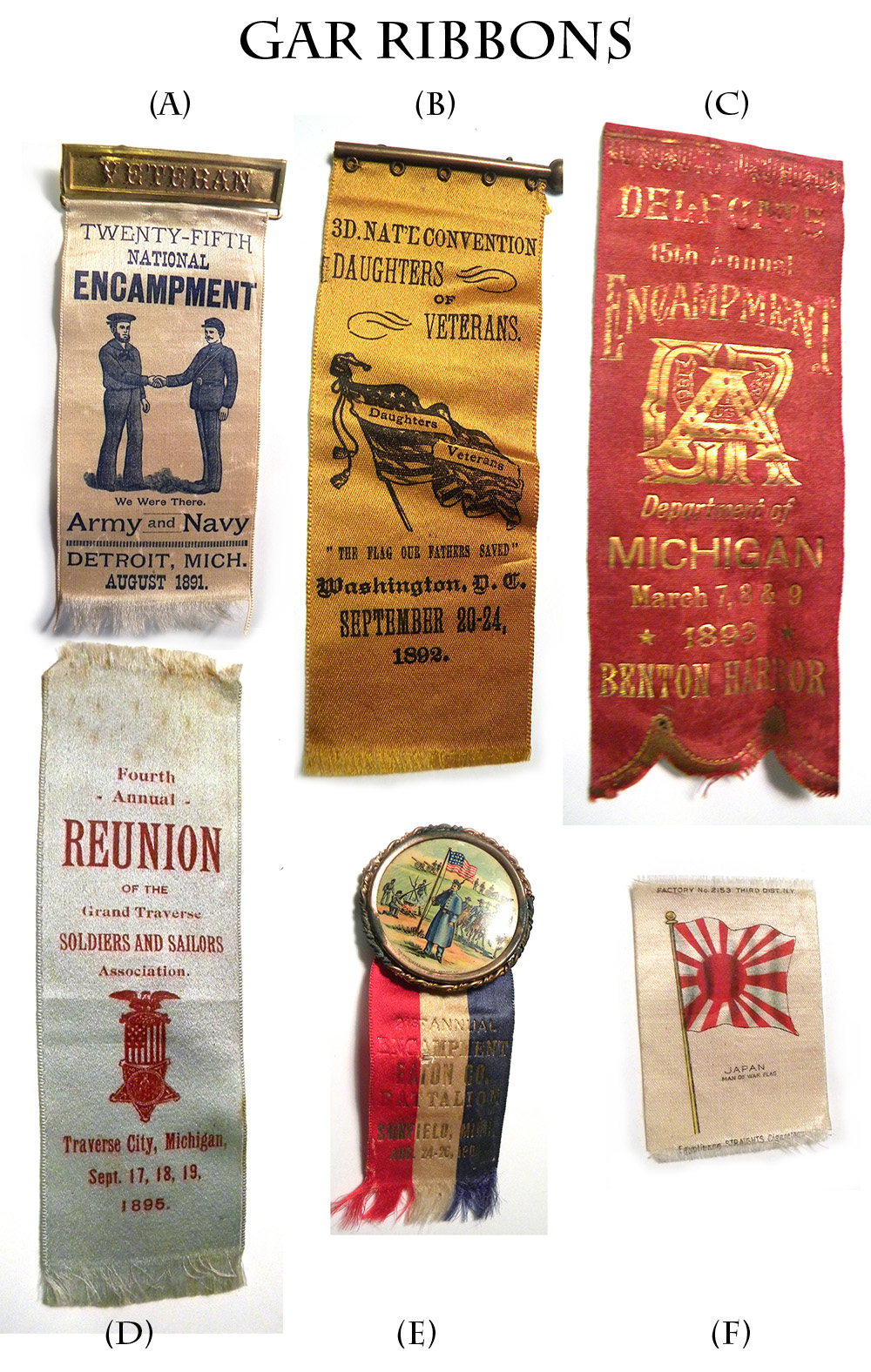
13-11-42 (A)
Silk Veterans Reunion Ribbon roughly six inches tall. Nice rendering of Union soldier and sailor. Detroit 1891.
… $25.00 SOLD
13-11-42 (B)
Gold Silk Ribbon Washington DC 1892 Daughters of Veterans. 7+ inches.
… $15
13-11-42 (C)
Red and Gold Dept. Of Michigan GAR reunion ribbon. Benton Harbor 1893. 8 inches tall.
… $25.00 SOLD
13-11-42 (D)
Traverse City Michigan Silk Reunion ribbon 1895, soldiers and sailors. 7+ inches
… $20 SOLD
13-11-42 (E)
Silk Ribbon w Celluloid Top of soldiers in camp. 21st encampment Eaton Co. Battalion Sunfield, Mich 1904. 4+ inches tall
… $25.00 SOLD
13-11-42 (F)
Little Jap Flag … printed pre ww1
… $15
Click Here to E-mail Us!
Call us @ 419-842-1863
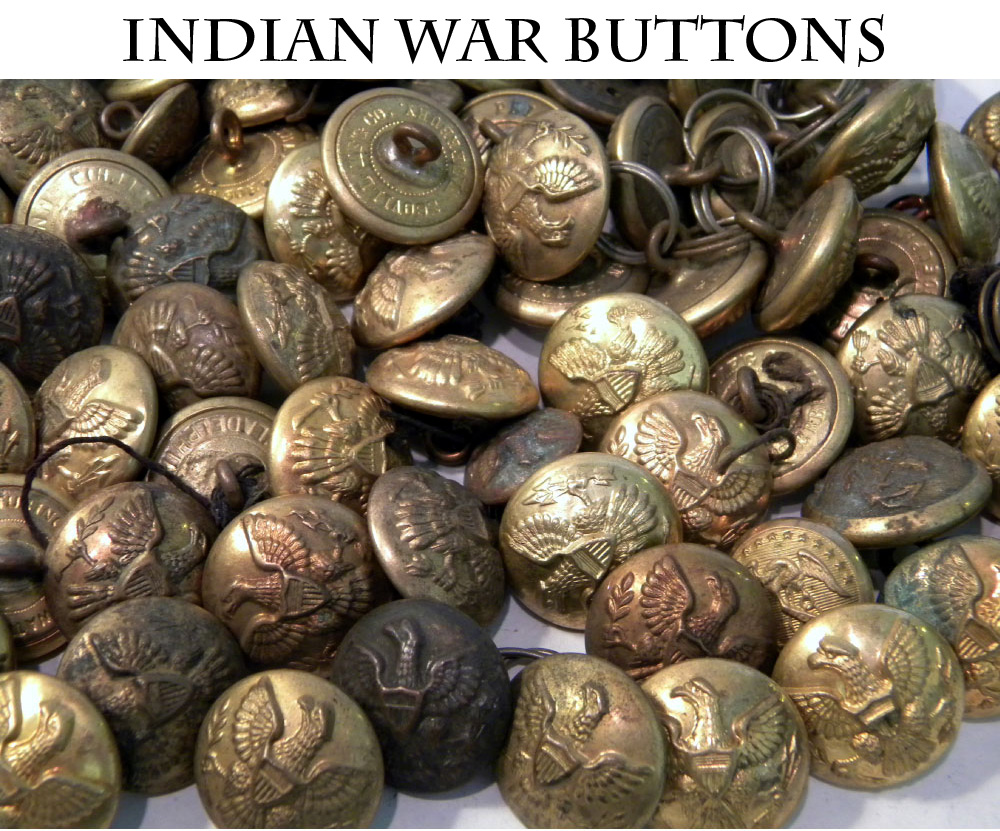
13-11-43 … A lot of TEN Original Indian War Large Size Eagle Coat Buttons.
A few years ago at an eastern Pennsylvania auction I bought a couple large bags full of these early Indian Fighters buttons and then I put them aside and forgot about them. I just stumbled across them again …. So here is a great opportunity …
TEN original buttons for $30.00 …
These can be mailed inexpensively in a padded envelope.
Click Here to E-mail Us!
Call us @ 419-842-1863
Layaways are Welcome
Need to split your order into multiple payments? No problem! A simple 20% earnest money deposit will hold your item for you.-acf
You can then pay it off in easy installments that fit your budget.
Read Terms Here
Items to Sell? Contact Us
I am always interested in buying ANYTHING from the American Civil War… Guns, Swords, Civil War Muskets, Knives, Uniforms, Flags, Medals, Badges, Diaries, Letters, Autographs, Buttons, photographs, tintypes, daguerreotypes, Insignia, Camp Items, Battlefield Relics, canteens, Drums, Etc… Call 419-842-1863 and ask for Dave Taylor.

